Oct 21, 2025 – Aegwangwon Autumn Outing, Happy Dialogue (4) Jinju
Hello. Today, Sunim planned to go on an autumn outing with residents of Aegwangwon, a residential facility for people with intellectual disabilities, and then hold a Happy Dialogue Dharma Q&A session in Jinju.
Since helping Aegwangwon recover from the severe damage caused by Typhoon Maemi in 2003, Jungto Society has been going on spring and autumn outings with Aegwangwon residents for over 20 years. For this outing, they decided to visit Hwaeomsa Temple and Cheoneunsa Temple in Jeolla Province.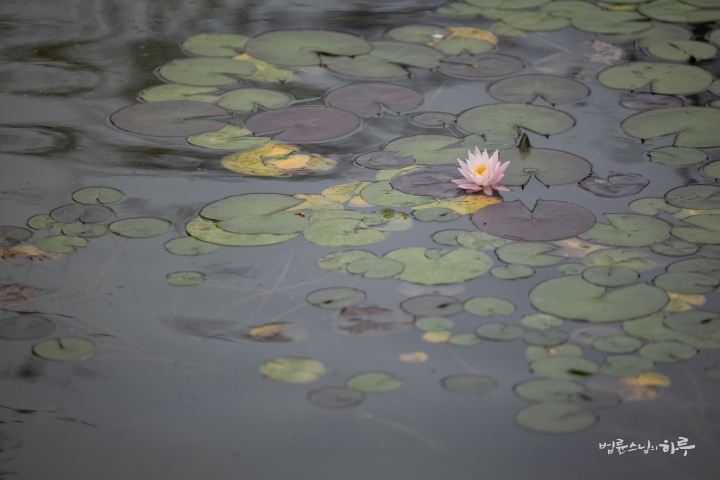
After completing morning practice and meditation, Sunim departed from Dubuk Jungto Retreat Center at 7 AM and headed to Hwaeomsa Temple in Gurye.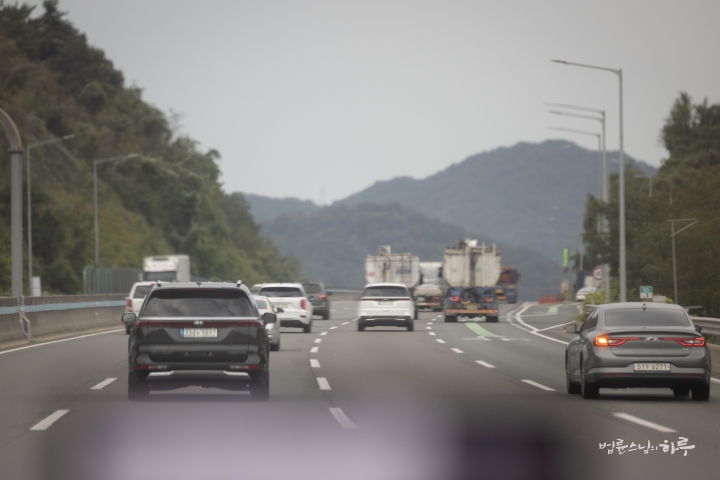
After a two-hour drive, the Seomjin River came into view. Following the Seomjin River and gradually approaching Mt. Jiri, they arrived at the entrance of Hwaeomsa Temple at 10 AM.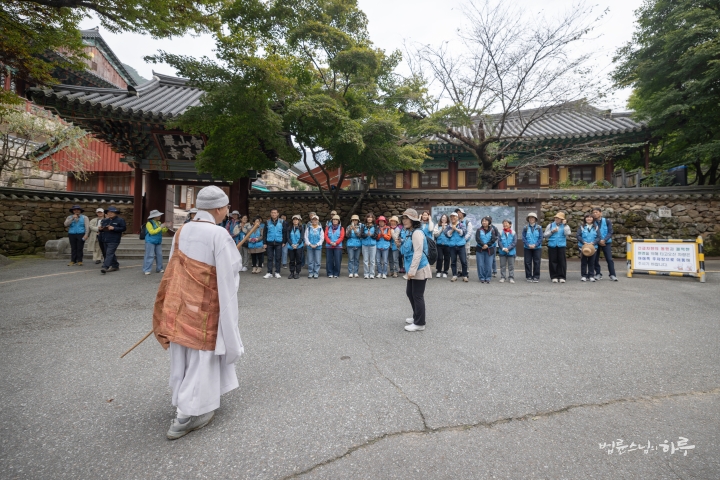
When Sunim got out of the car, about 40 members of the Gyeongnam branch of Jungto Society wearing JTS vests were waiting for the Aegwangwon residents.
After greeting the volunteers, Sunim first took a commemorative photo with them.
“Thank you for your hard work today.” 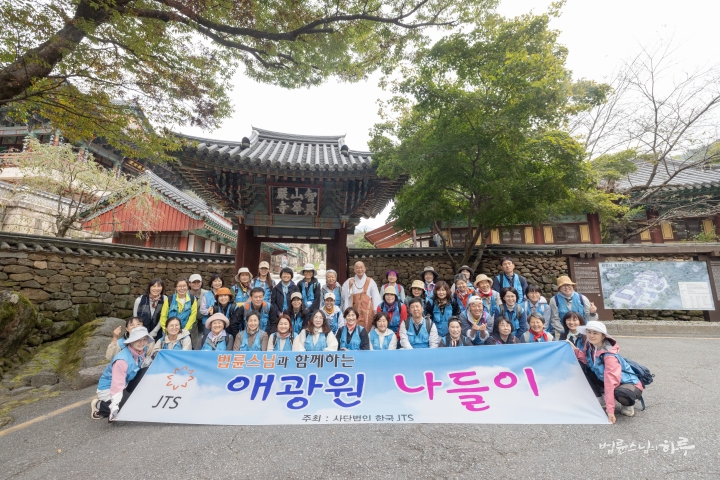
After exchanging greetings with the volunteers, Sunim took a preliminary tour around Hwaeomsa Temple.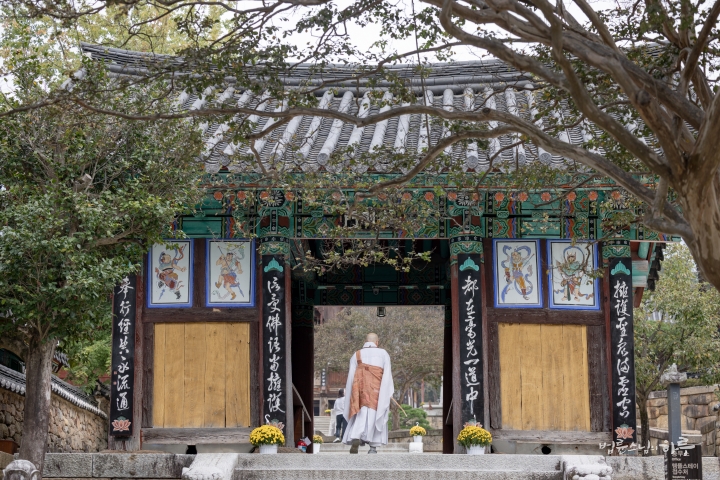
Venerable Beomjeong, who serves as the public relations director of Hwaeomsa Temple, came to greet Sunim. Hwaeomsa Temple had also prepared snacks for the Aegwangwon residents. After exchanging warm greetings, they waited together in front of the One Pillar Gate to welcome the Aegwangwon residents.
At 10:30 AM, the bus carrying the Aegwangwon residents arrived. Today, 30 residents with mild disabilities came on the outing, along with the CEO and 10 staff members. Sunim greeted each person warmly at the bus door, making eye contact with them one by one.
“Welcome!”
“Hello, Sunim!”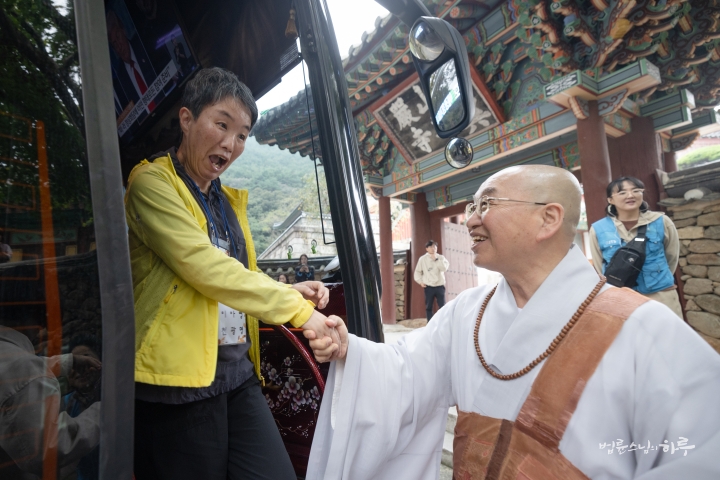
The Aegwangwon residents who got off the bus holding Sunim’s hand then took the hands of volunteers. These were their partners for today’s outing. Some residents recognized the volunteers’ faces and gave them big hugs.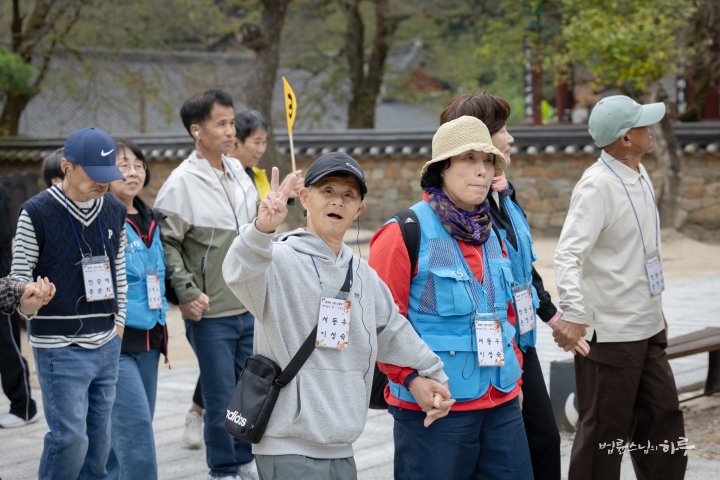
The residents and volunteers first went to the restroom hand in hand. Sunim waited in front of the Hwaeomsa Temple guide map for all the Aegwangwon residents to gather.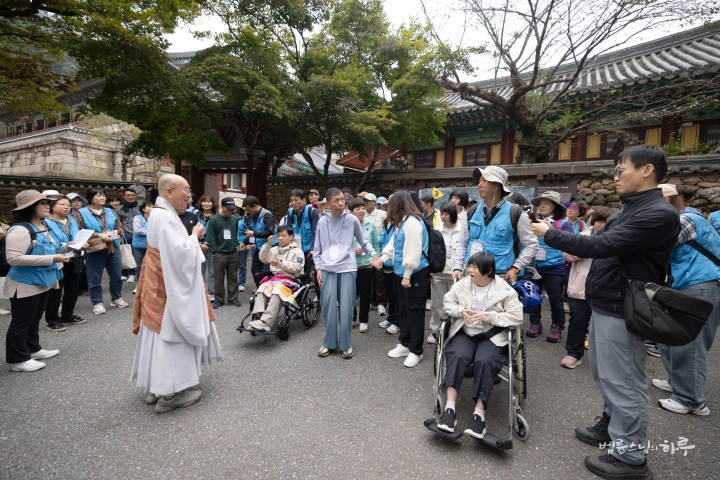
Their brightly smiling faces were filled with joy. Once all the residents had gathered, Sunim greeted them warmly.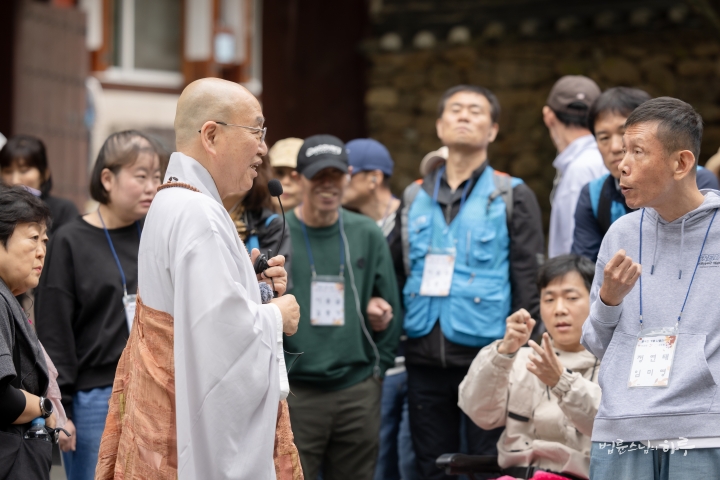
“Brothers and sisters of Aegwangwon, it’s wonderful to see you again. Do you remember me?”
“Yes, we know you!”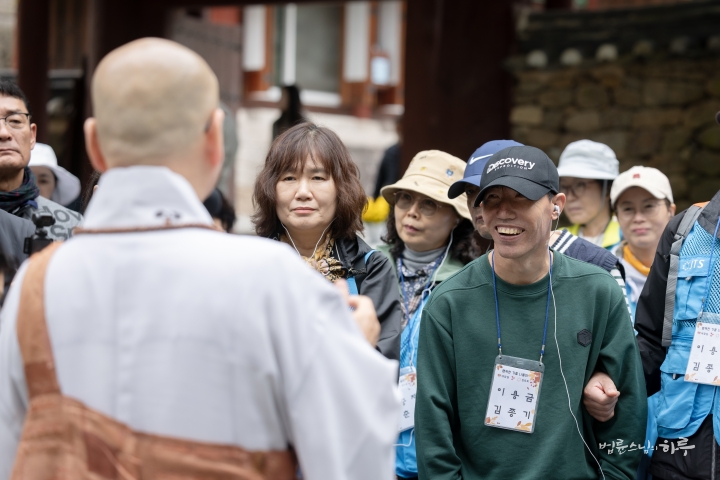
They shouted from here and there, nodding their heads. Sunim smiled back and began his explanation.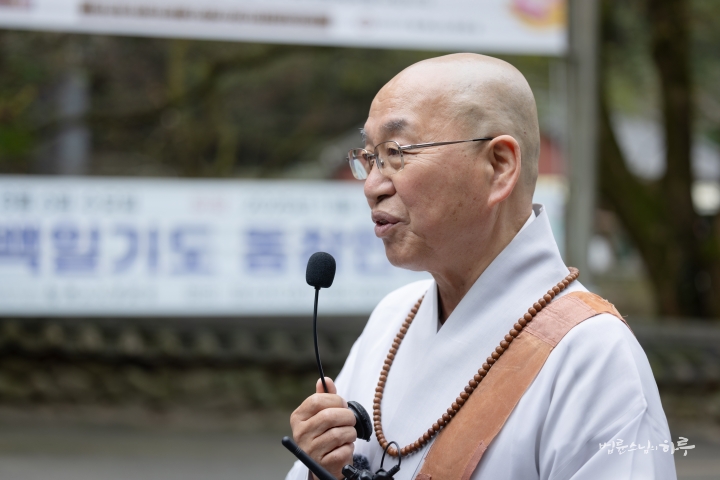
“We have arrived here at Hwaeomsa Temple in Gurye County, Jeollanam Province. Hwaeom means ‘adorned with flowers.’ Just as we create a flower garden with various flowers harmoniously arranged, the Buddha’s various teachings are contained in a sutra called the Avatamsaka Sutra, comparing his words to flowers. This temple, Hwaeomsa, was built to realize the philosophy of the Avatamsaka Sutra. Here, we’ll take walks and explore together.
The Aegwangwon staff work very hard every day, but today our volunteers will take over that role. I hope the Aegwangwon staff will just watch to ensure everyone’s safety and enjoy the day with us.”
The residents listened to the explanation with bright, attentive eyes, nodding their heads.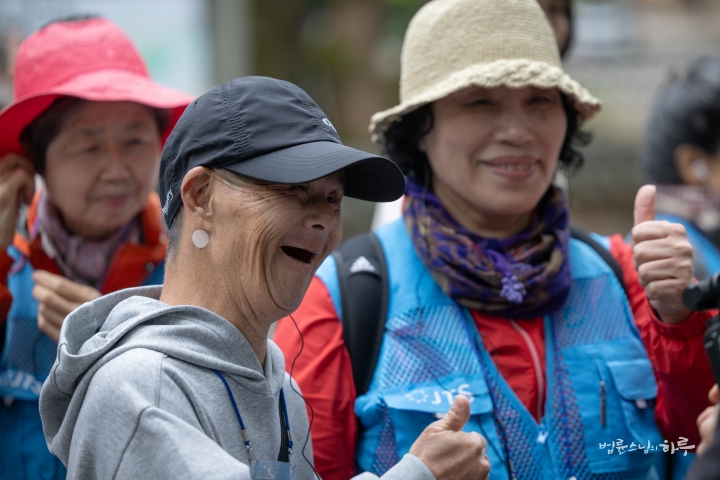
Next, Ms. Song, Woo-jeong, CEO of Aegwangwon, gave a greeting.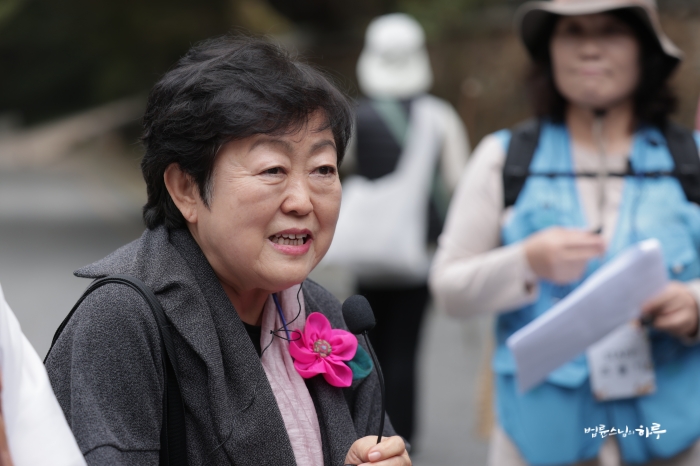
“Our friends have been waiting for today for a long time. Although the weather is a bit chilly, I hope your warm hearts will reach our Aegwangwon friends and make this a pleasant day. I hope our friends will listen carefully to Sunim’s words and have an enjoyable time.”
Next, Sunim gave a brief explanation about Hwaeomsa Temple.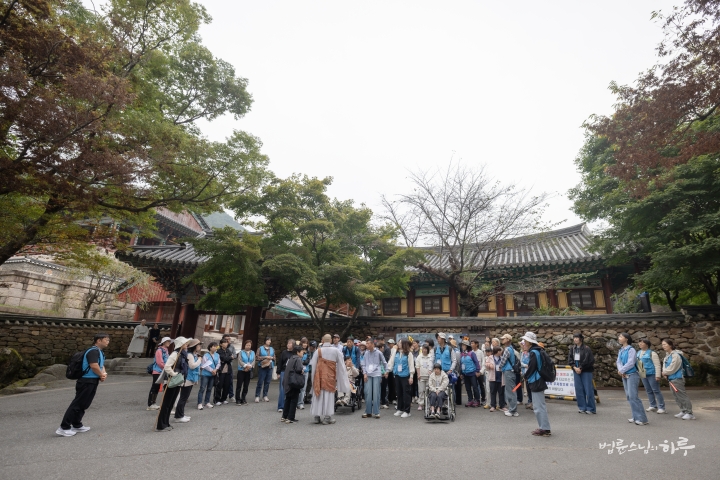
“Hwaeomsa Temple was built 1,500 years ago. There are various theories, but it’s known to have been built during the reign of King Jinheung of Silla. At first glance, you might think it was a Baekje temple, but this area was originally Gaya territory. Later, during King Jinheung’s reign, Gaya was integrated into Silla, so this became Silla territory.
Since it burned down during the Japanese invasions of Korea, all the wooden buildings were restored after that period. Among them, the building that represents this temple is Gakhwangjeon Hall. It’s very large in scale. During the era when Confucianism dominated society, it was difficult for Buddhism to receive state support. So to build such a large-scale building, a major donor was essential. There are various legends related to this, and I’ll share one of them with you. 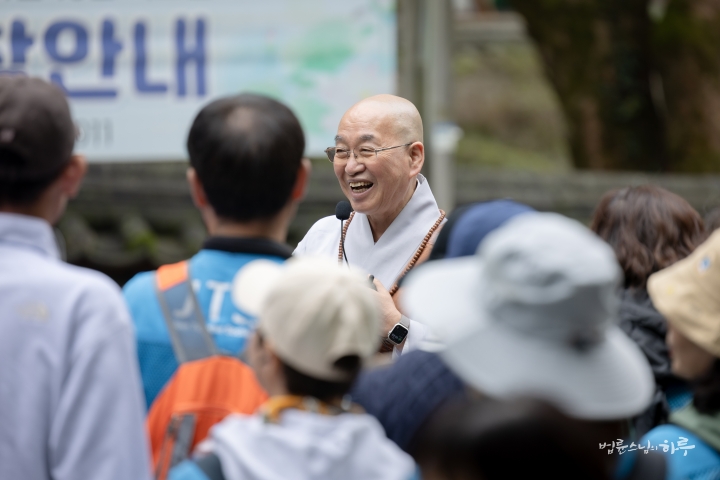
The head sunim of this temple offered a 100-day prayer to build Gakhwangjeon Hall. As the prayer period was coming to an end, whether in a dream or in reality, a sage appeared and said, ‘Your devotion is truly admirable. After completing your 100-day prayer, when you leave the temple gate, the first person you meet will be the benefactor who will build this temple.’
After finishing his prayer, the sunim kept those words in his heart and descended the mountain with his bag. However, the first person he encountered on his way down was none other than a beggar.”
The residents were shocked, their eyes widening in unison.
“A beggar?”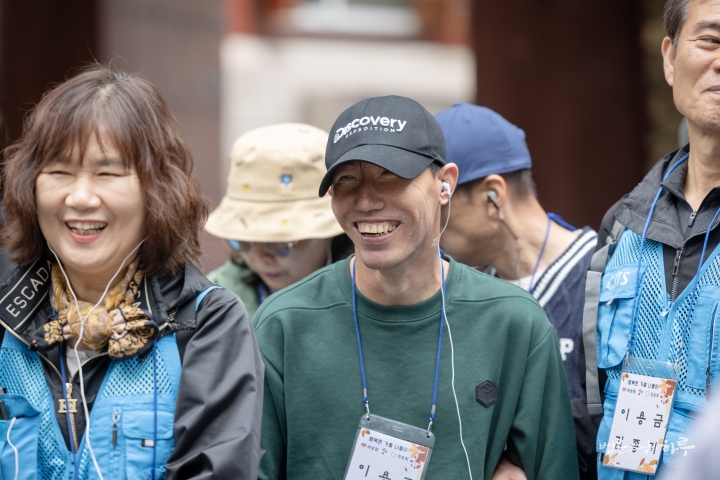
Sunim continued his explanation.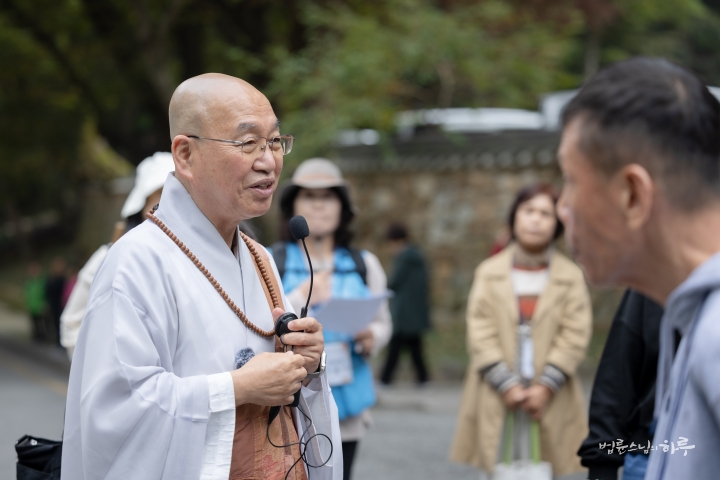
“It’s logically impossible for a beggar to make a donation large enough to build such a grand temple. However, believing this person was designated by the Buddha, the sunim approached the beggar and respectfully said, ‘You are the benefactor who will build this temple. Please make a donation.’ The beggar was shocked and replied,
‘Sunim, are you in your right mind? I don’t even have food for today!’
Nevertheless, the sunim continued to ask the beggar to make a donation to build the temple, while the beggar insisted he couldn’t. As the beggar backed away, he accidentally stepped into a well and lost his life on the spot. The sunim fell into deep remorse. Far from building a temple, he was tormented by the thought that he had caused the loss of a life. According to the story, after his death, the beggar was reborn as an emperor of the Qing Dynasty. Later, the emperor couldn’t sleep because a monk appeared in his dreams every night asking for donations. Eventually, someone explained that the dream was related to a karmic connection from a past life. Upon hearing this, the emperor decided to make the donation, and the temple was completed. The temple completed in this way is today’s Gakhwangjeon Hall. It was named by combining the characters ‘gak (覺)’ meaning ‘awakened’ and ‘hwang (皇)’ meaning ’emperor,’ thus meaning ‘Hall of the Awakened Emperor.’
The Buddha Comes to Us in the Form of the Poor
So why did such a story come about? It conveys the message that the most humble person in the world is the true Buddha. The teaching is that not the sunims practicing in grand temples, nor the powerful, the wealthy, or kings are Buddhas, but those we consider insignificant are the true Buddhas. 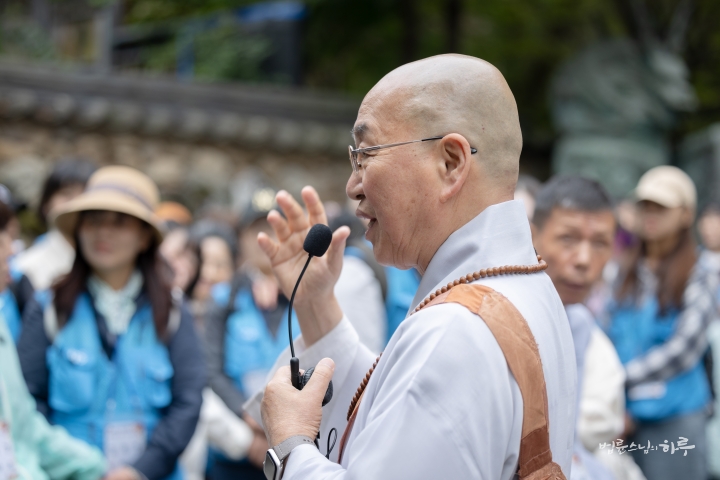
The Bible conveys the same message. Jesus said, ‘Whatever you did for one of the least of these, you did for me.’ The ‘least of these’ refers to the thirsty, the hungry, the naked, the sick, the stranger, and the imprisoned. Good deeds done for them are equivalent to doing them for God. Similarly, we should not look down on anyone because they are poor, disabled, old, female, or foreign. Through this tale, we can learn once again that Buddha or God comes to us in the form of these humble people.
Now, let’s get started. The first gate you pass through when entering a temple is Iljumun Gate. So, let’s first pass through Iljumun Gate.”
The volunteers held the residents’ hands tightly and carefully walked up the slope after passing through Iljumun Gate side by side. As the cool autumn breeze brushed their faces, the residents’ expressions became more relaxed.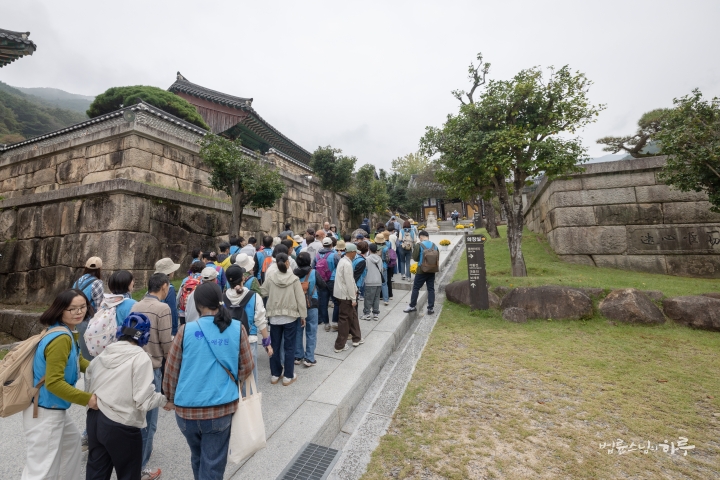
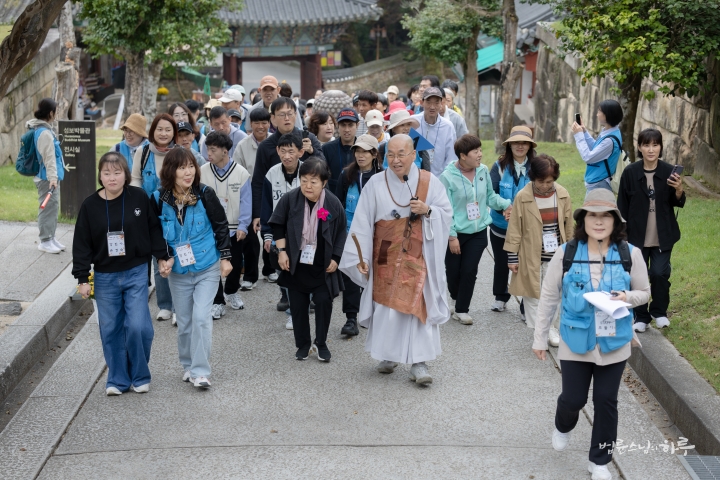
On the path leading up to Cheonwangmun Gate, cute Buddha statues stood in a row, each with a line from the scriptures written on it. In front of a Buddha statue covering its eyes was written, ‘Do not strive to see others’ faults, do not look at what others do or don’t do.’ Sunim read the inscription himself and explained its meaning.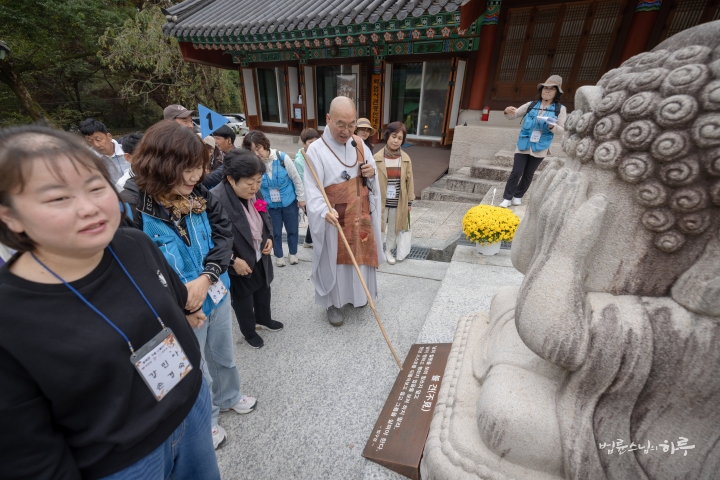
“It means to look at yourself. There’s a similar saying in the Bible. Jesus said, ‘Why do you look at the speck of sawdust in your brother’s eye and pay no attention to the plank in your own eye?’ It’s exactly the same message.”
While listening attentively to Sunim’s explanation, they had already passed Geumgangmun Gate and arrived in front of Cheonwangmun Gate. Huge wooden sculptures with fierce faces stood there. Several people, overwhelmed by their majesty, gulped and whispered:
“It’s scary!”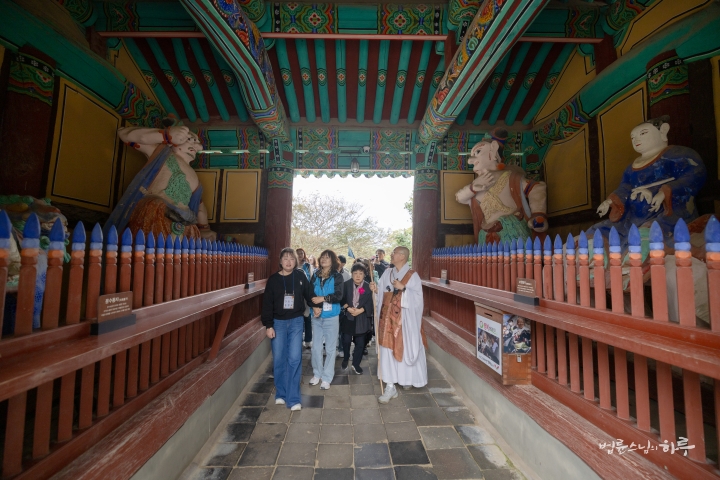
Sunim said,
“You don’t need to be afraid. These are the Four Heavenly Kings, guardian deities who protect people entering the temple with pure hearts.” 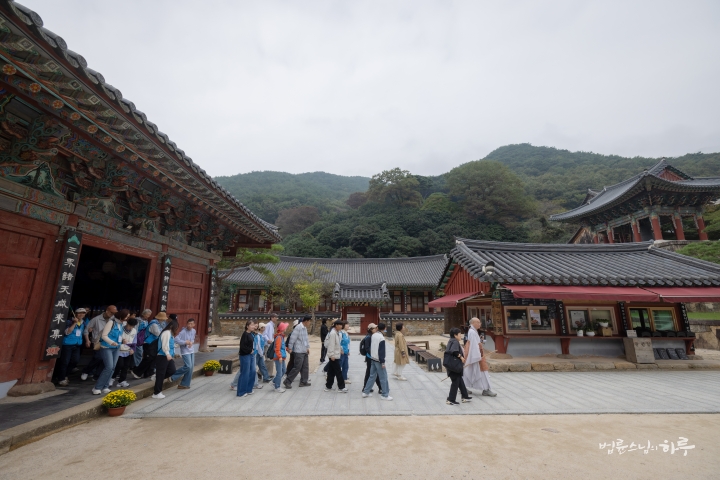
After passing through Cheonwangmun Gate, another scripture verse caught their eye. This time, a couplet hanging on a pillar read, ‘A face without anger is the true offering.’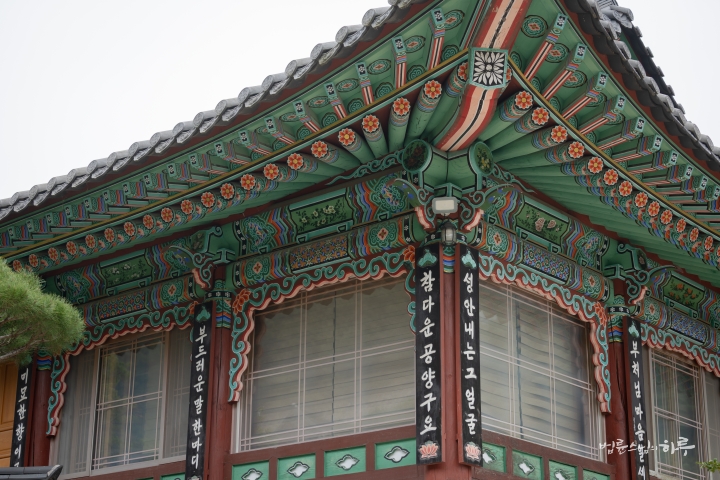
Sunim explained with a smile.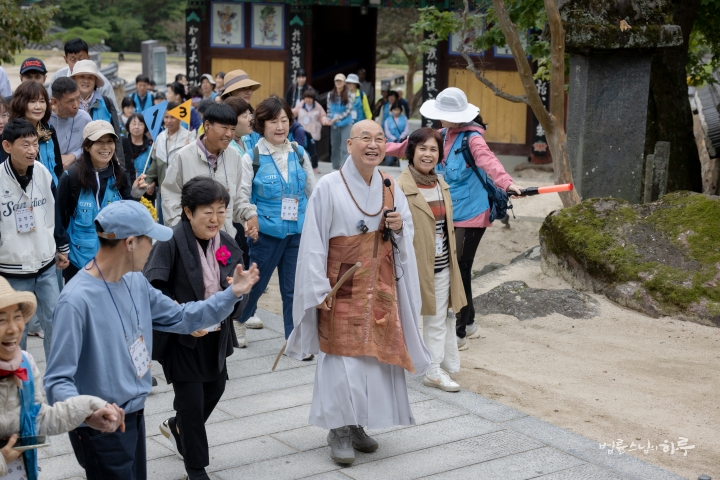
“You know how you get angry and lose your temper, and then pray to God afterward? Rather than that, not getting angry itself is the true prayer. Got it?”
“Yes!”
As they climbed higher, Bojeru appeared.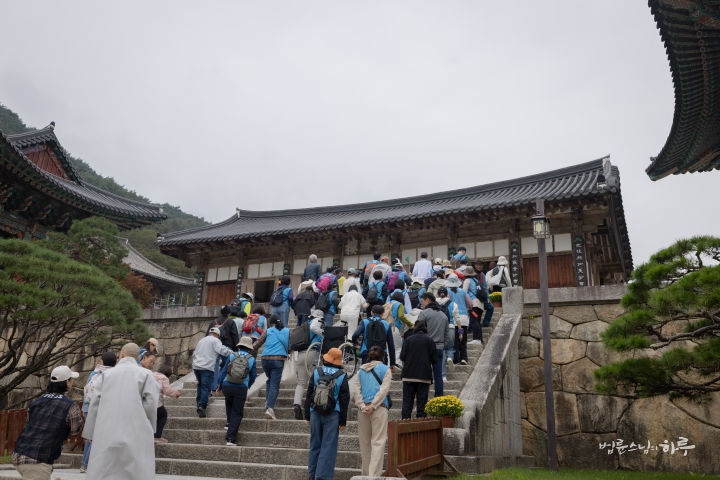
Most temples are designed so that you pass under Bojeru, but Hwaeomsa Temple’s layout requires going around the side of Bojeru. Sunim explained the reason for this.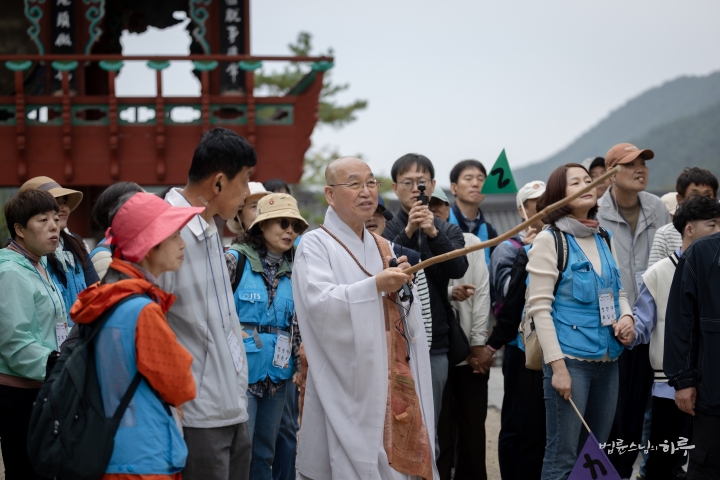
“Usually, since the center of a temple is Daeungjeon Hall, the temple layout is arranged so that the east and west pagodas form perfect symmetry in front of Daeungjeon Hall. However, at Hwaeomsa Temple, Gakhwangjeon Hall, which is larger than Daeungjeon Hall, is positioned to the left, creating an imbalance. But when you go around the side of Bojeru and stand here looking at Daeungjeon Hall and Gakhwangjeon Hall, it appears balanced with the east pagoda in front of Daeungjeon Hall and the west pagoda in front of Gakhwangjeon Hall. They built it this way to adapt to the terrain while incorporating Buddha’s teachings, preserving artistic beauty, and creating visual effects.” 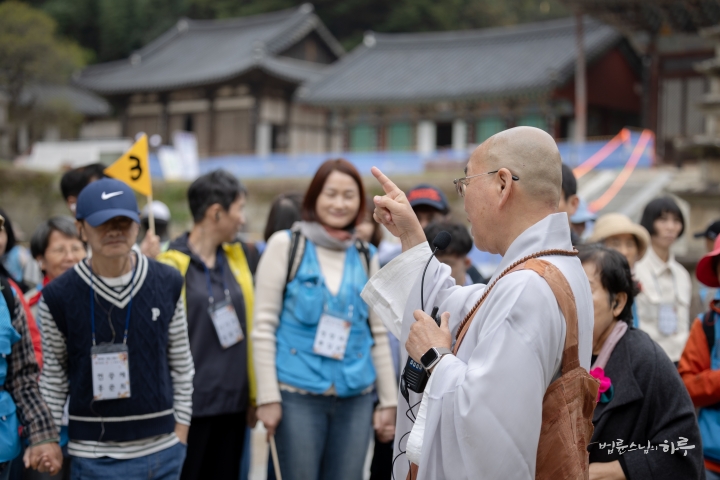
They took a commemorative photo together with Gakhwangjeon Hall, the representative building of Hwaeomsa Temple, as the backdrop.
“Aegwangwon, fighting!”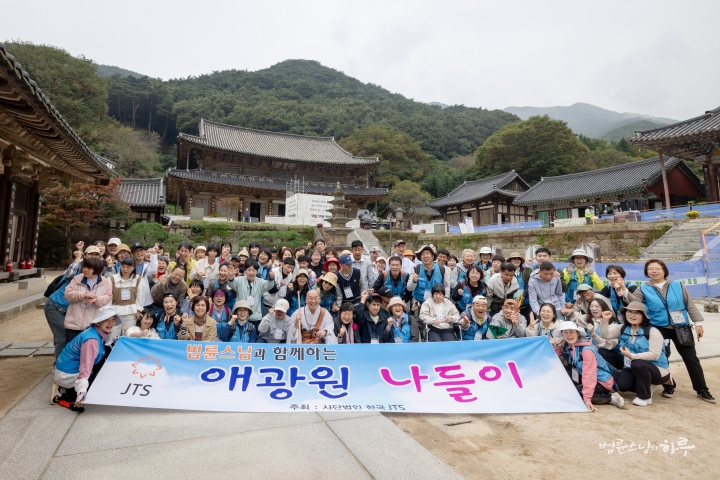
After finishing the photo shoot, one of the Aegwangwon residents approached Sunim, held his hand tightly, and smiled. Sunim also smiled and expressed his joy at the reunion.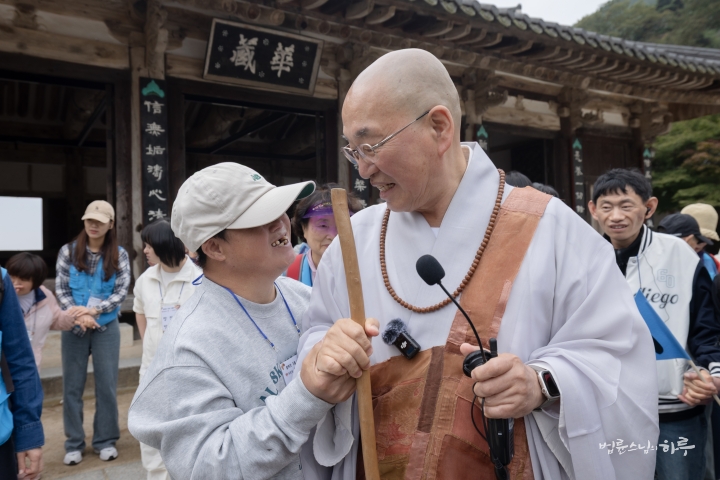
“How did you lose all your teeth?”
The Aegwangwon residents were simply happy to see Sunim again. They kept smiling whenever they saw him.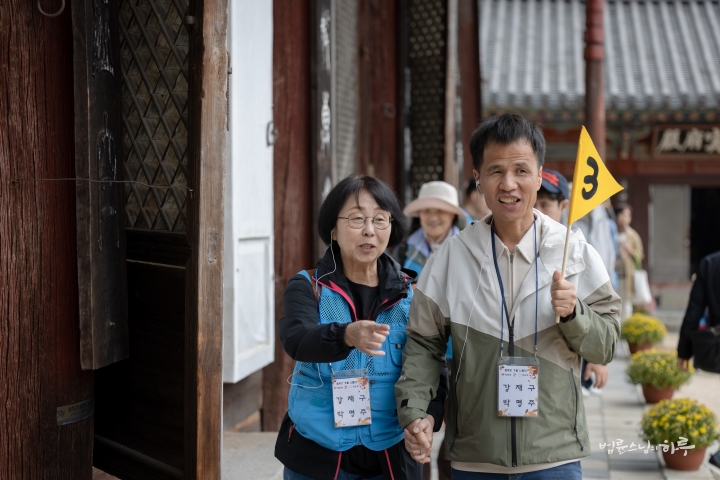
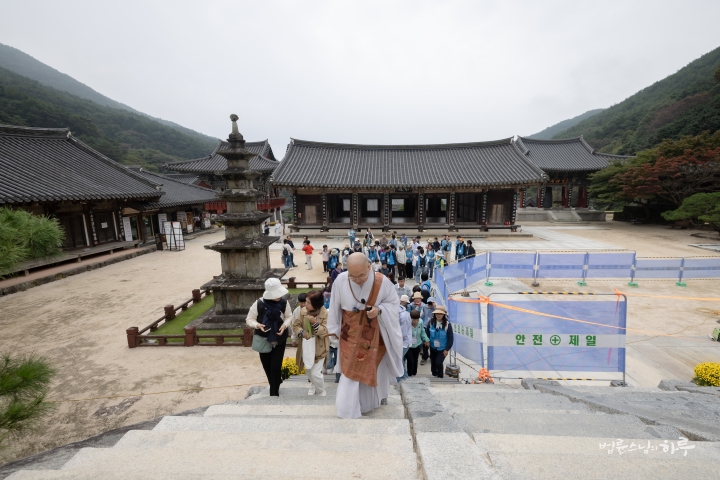
While Sunim paid his respects at Daeungjeon Hall, the Aegwangwon residents took group photos in front of the hall.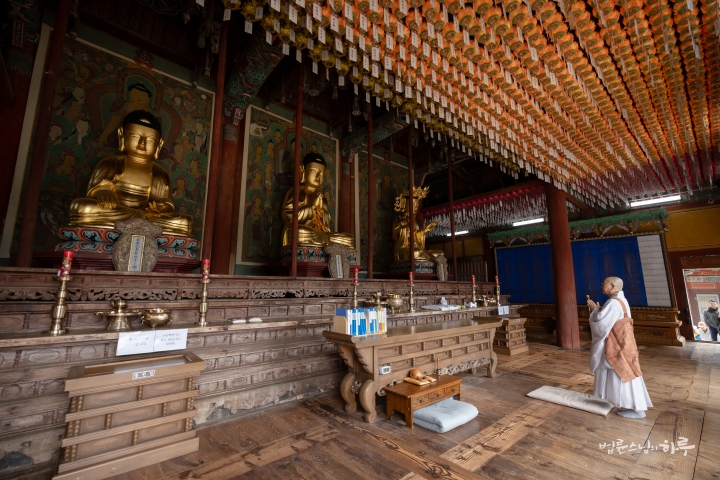
They then passed by Wontongjeon Hall and Nahanjeon Hall, finally arriving in front of Gakhwangjeon Hall.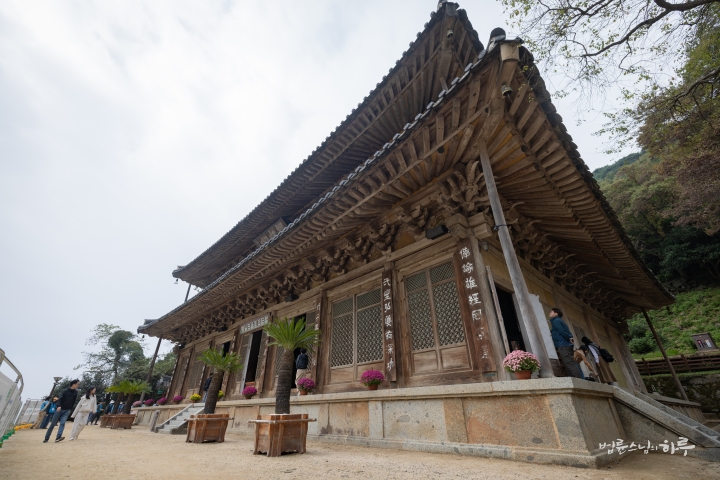
Sunim continued his explanation.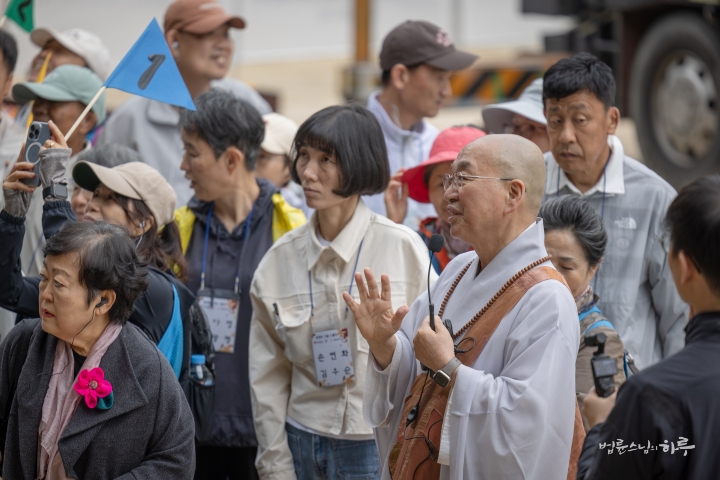
“This stone lantern in front of Gakhwangjeon Hall is a National Treasure. It’s currently disassembled for restoration. Looking at Gakhwangjeon Hall up close, it’s quite large, isn’t it? This building was constructed through the vow of a beggar. So you shouldn’t look down on poor and destitute people. God doesn’t appear in this world as a king or a wealthy person, but manifests as the least among us.”
After passing Gakhwangjeon Hall, stairs leading up to the Four Lions Three-Story Stone Pagoda appeared on the high ground to the northwest of the temple. The stairs were steep and dangerous, raising concerns about whether the Aegwangwon residents could climb them. So Sunim asked in a loud voice.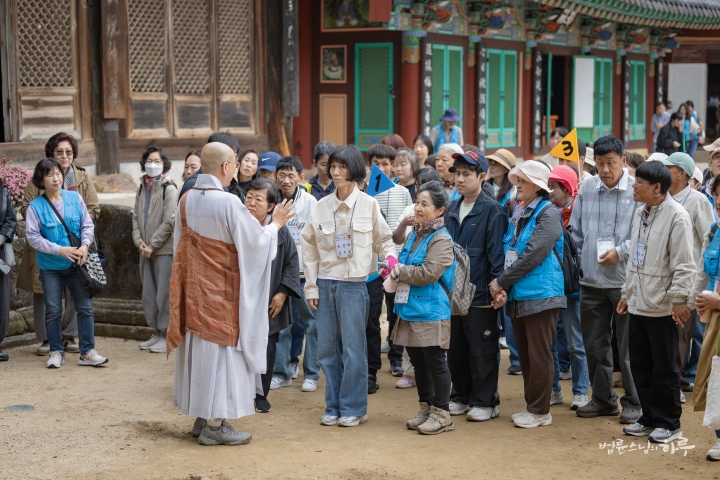
“There’s a stone pagoda up there. Raise your hand if you want to walk up the stairs to see it.”
Everyone raised their hands high. The Aegwangwon staff were worried about coming back down, but they felt reassured by the many JTS volunteers who could provide support, so they followed the residents’ wishes.
They climbed carefully, one step at a time, chanting “Left foot, right foot!” Beads of sweat formed on their foreheads.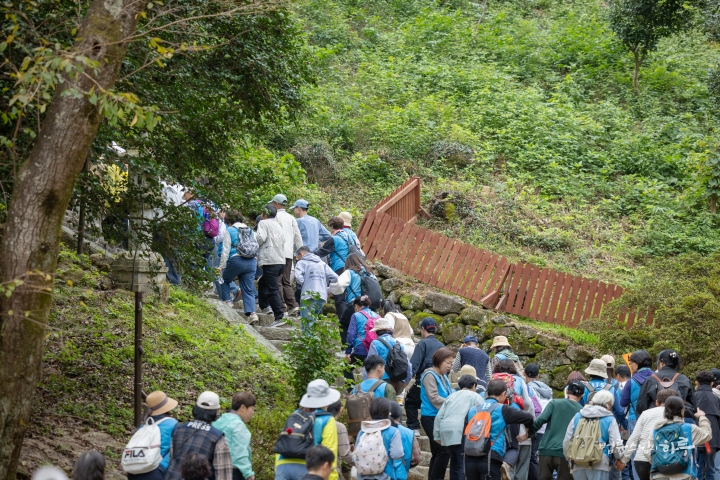
When the stairs ended, the Four Lions Three-Story Stone Pagoda finally revealed itself in a place surrounded by pine trees.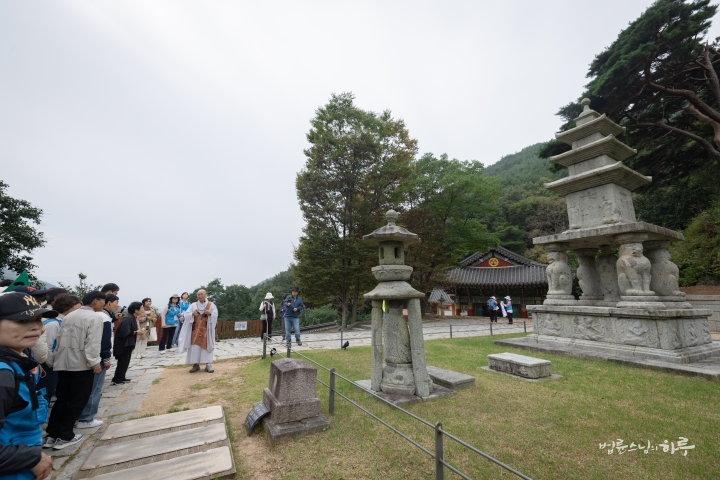
“This is the three-story stone pagoda supported by four lions. In the center, a sunim is supporting the pagoda with his head. Such a unique pagoda is called an irregular pagoda. Take a look at the surrounding scenery. Wasn’t it worth coming?”
“Yes!”
“Thanks to you all, I’m also visiting here again after 30 years.” 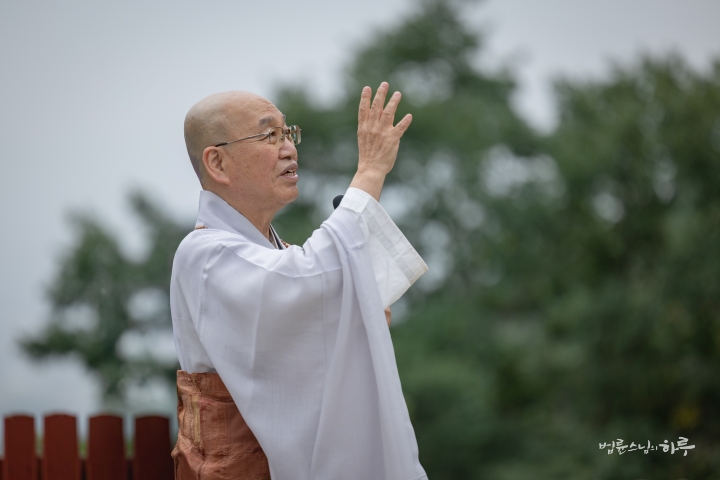
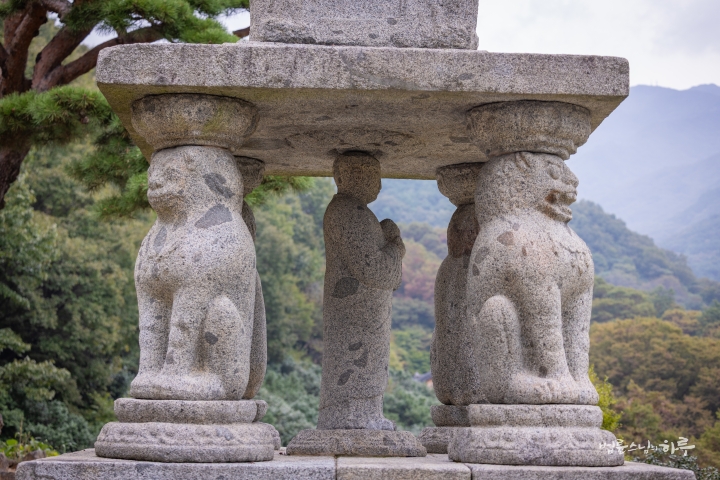
After taking a commemorative photo with the Four Lions Three-Story Stone Pagoda as the backdrop, they came back down the stairs.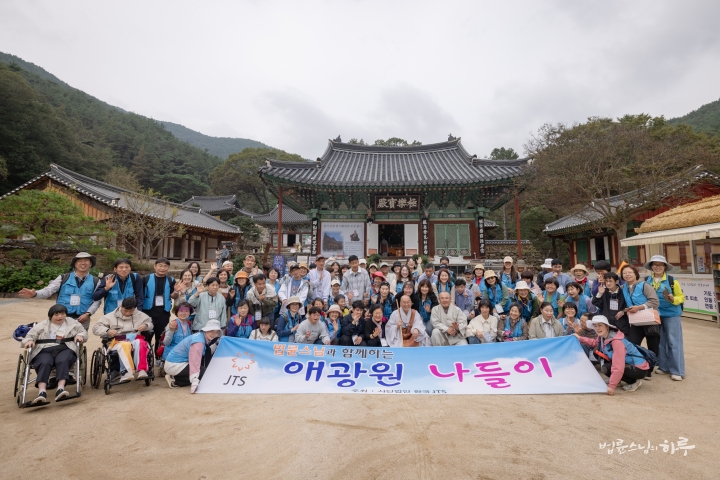
“The stairs are steep, so volunteers, please hold the Aegwangwon residents’ hands tightly and help them down carefully.” 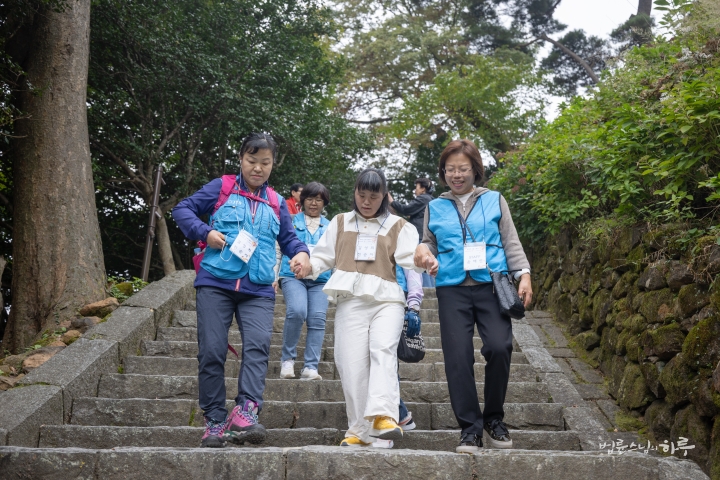
After everyone safely descended the stairs, Sunim entered Gakhwangjeon Hall to pay his respects. Inside Gakhwangjeon Hall was enshrined the portrait of Master Dongheon Wangyu, a Dharma disciple of Master Yongseong.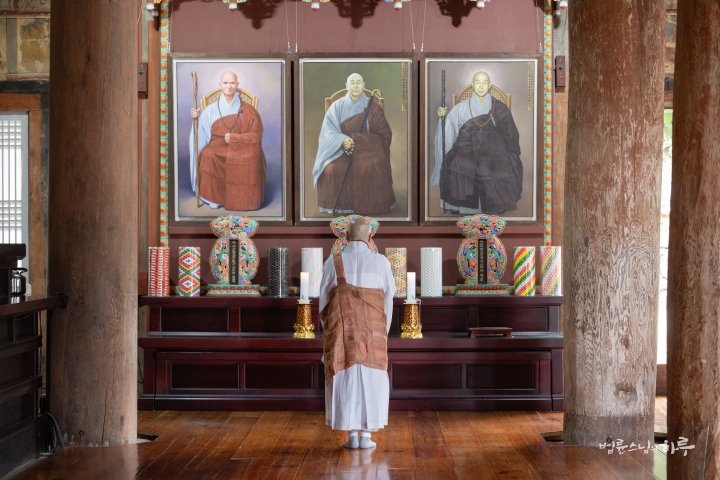
After paying respects at Gakhwangjeon Hall, Sunim returned to guide the Aegwangwon residents gathered in front of Daeungjeon Hall.
“It’s lunchtime now. We’ve prepared plenty of food at the restaurant, so please enjoy your meal.”
The Aegwangwon residents and volunteers moved to a nearby restaurant, while Sunim had tea and conversation with Useok Sunim, who had recently become the new abbot of Hwaeomsa Temple.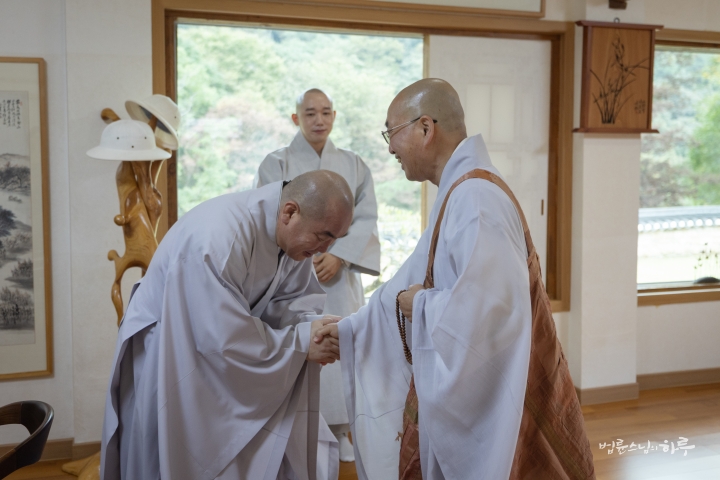
At the request of the previous abbot, Deokmun Sunim, a Dharma Q&A session had been held at Hwaeomsa Temple five years ago. Useok Sunim was planning various projects to inherit Deokmun Sunim’s achievements and further expand the temple’s value as a cultural space, opening new possibilities for temples.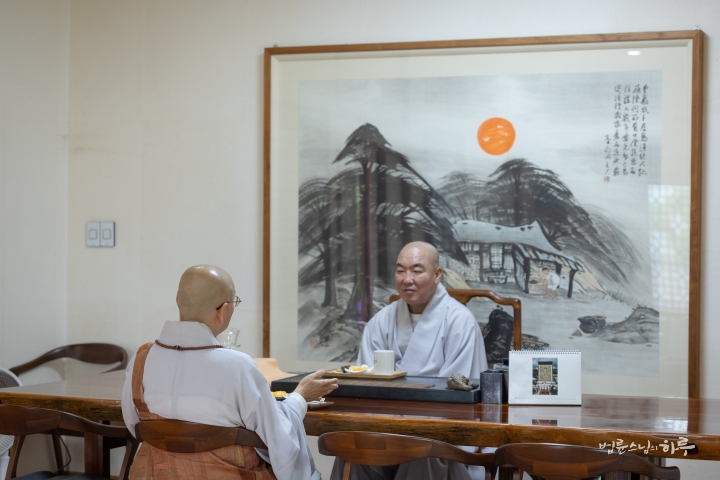
Since Master Dongheon Wangyu, a disciple of Master Yongseong, had passed away as the spiritual leader of Hwaeomsa Temple, an annual memorial service is held here. Sunim expressed his gratitude to the abbot for this dedication and left Hwaeomsa Temple.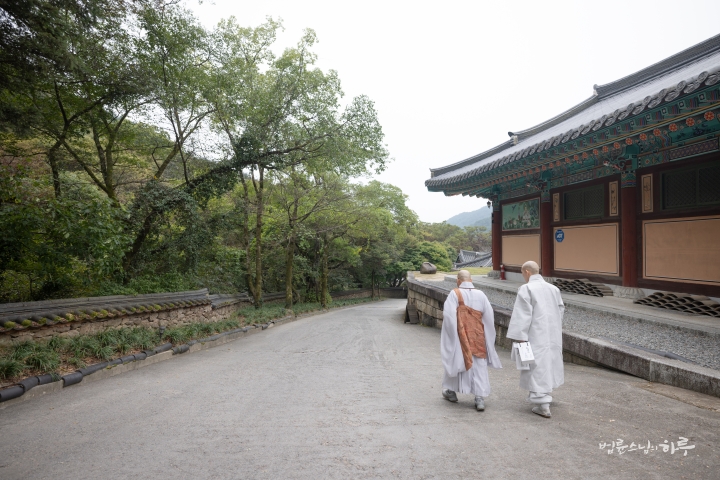
During the bus ride, the Aegwangwon residents practiced songs they would sing during the afternoon talent show. Humming could be heard from here and there.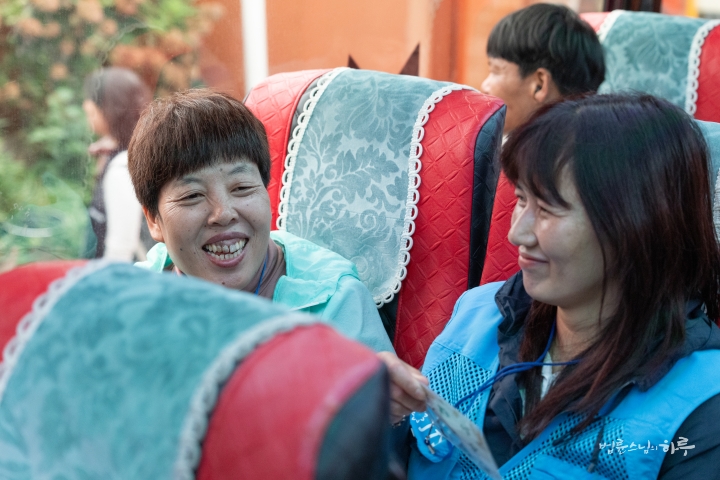
After finishing tea, Sunim also headed to the restaurant. When he arrived, volunteers were sitting one-on-one with Aegwangwon residents, helping them with their meals.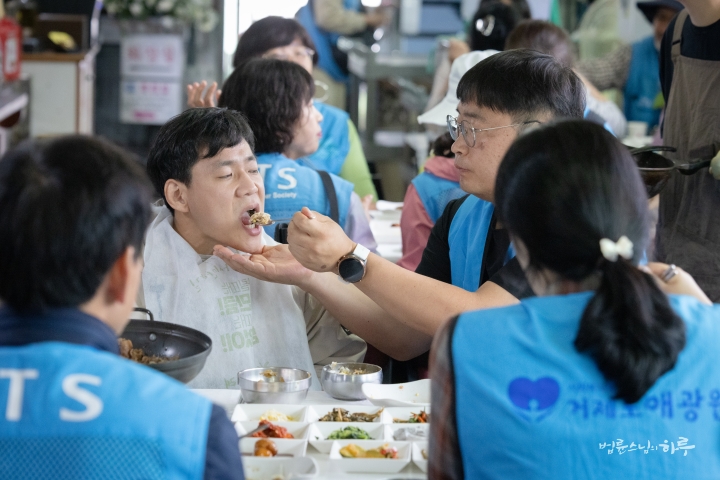
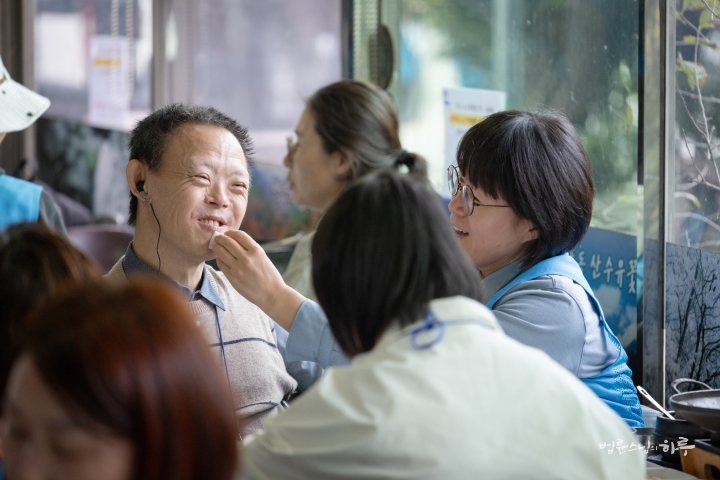
The residents, in good spirits from their rare outing, enjoyed their meals while making heart signs to volunteers and putting arms around their shoulders.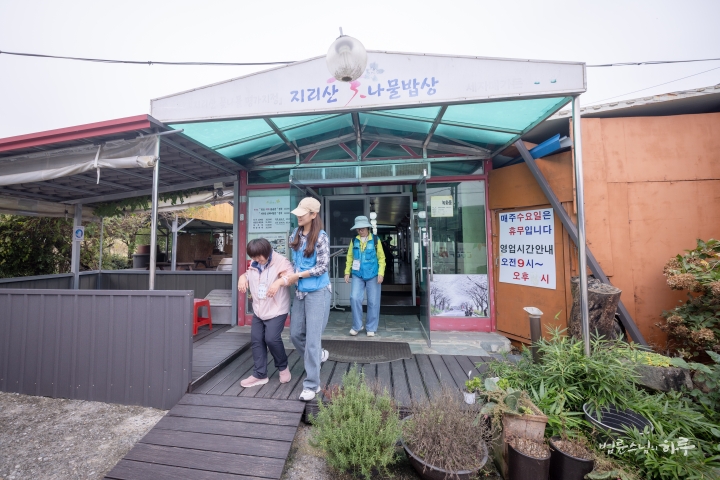
After lunch, they headed to the Jirisan History and Culture Center in the afternoon. After getting off at the parking lot and crossing a pond with fountains, a wide central plaza appeared.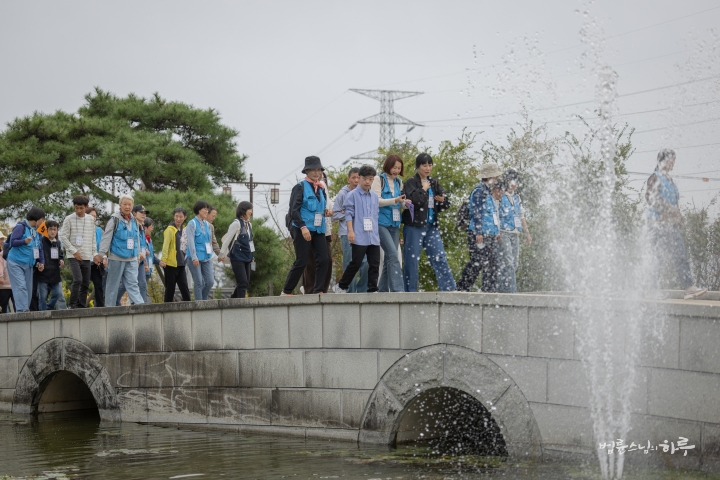
They took a group photo together in the central plaza and then toured Exhibition Hall 1.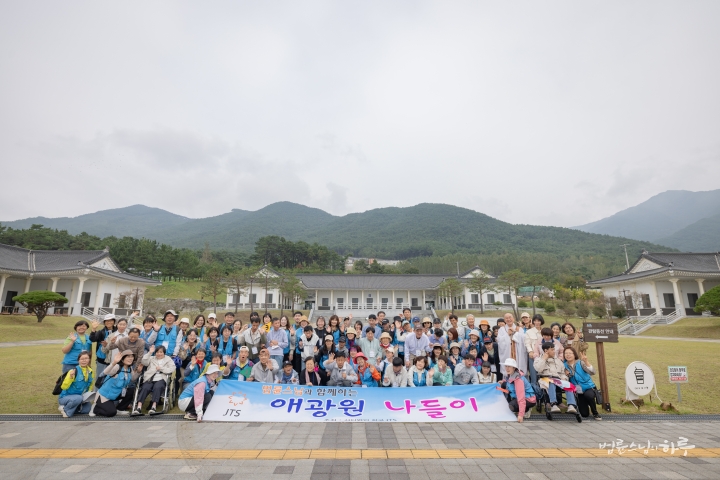
Hall 1 displayed various artifacts and photographs showing the Seomjin River that winds around Gurye and Jirisan, as well as glimpses of life during the agricultural era.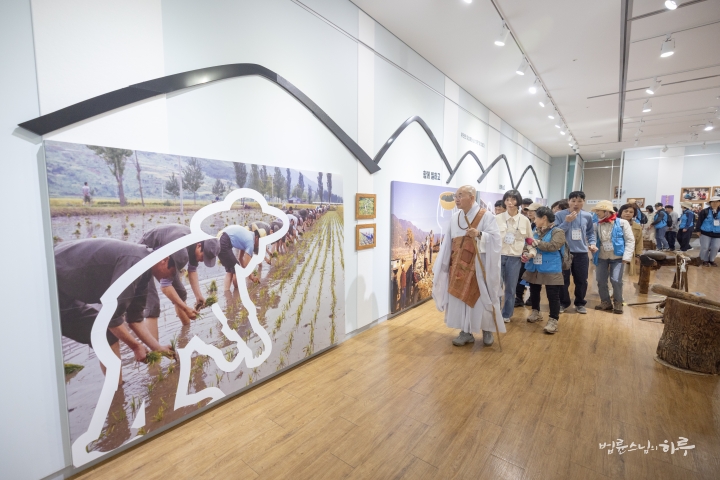
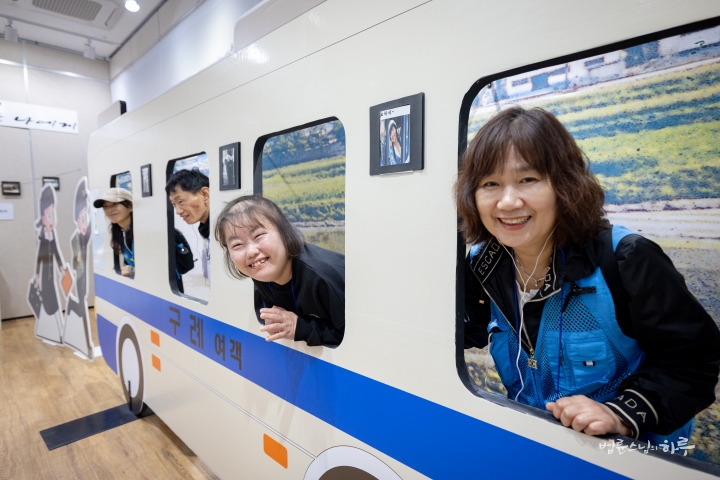
After viewing various photographs, they found equipment for experiencing traditional games set up in the courtyard. The Aegwangwon residents enjoyed playing various games with volunteers, including ttakji (paper tile flipping), jegichagi (shuttlecock kicking), yutnori (traditional board game), tuho (arrow throwing), top spinning, hoop rolling, and making a map of the Korean Peninsula.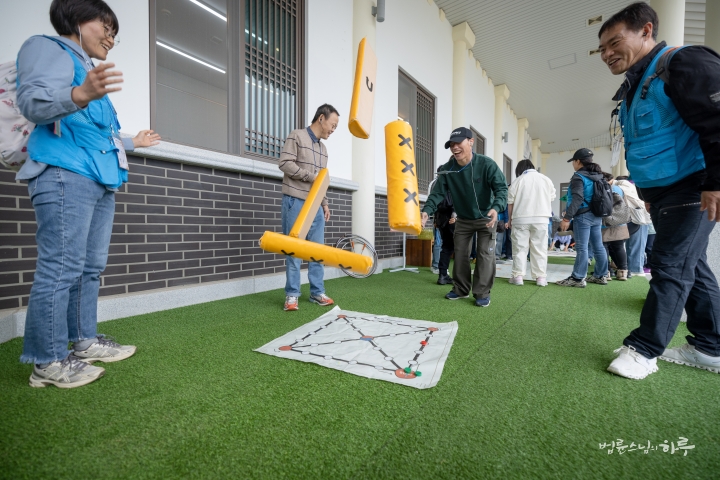
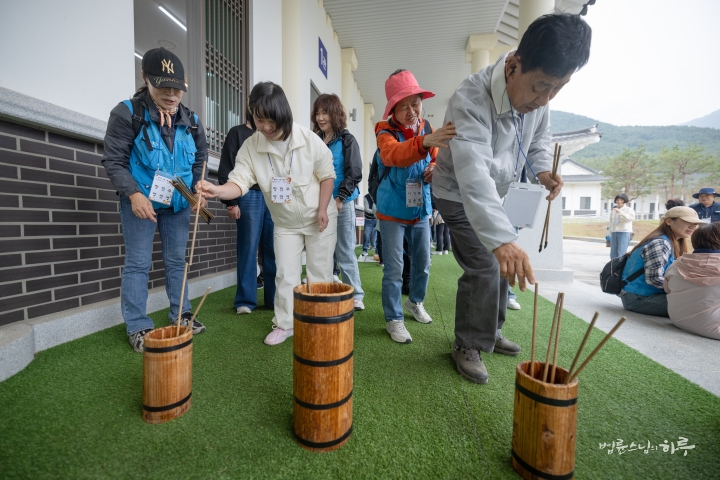
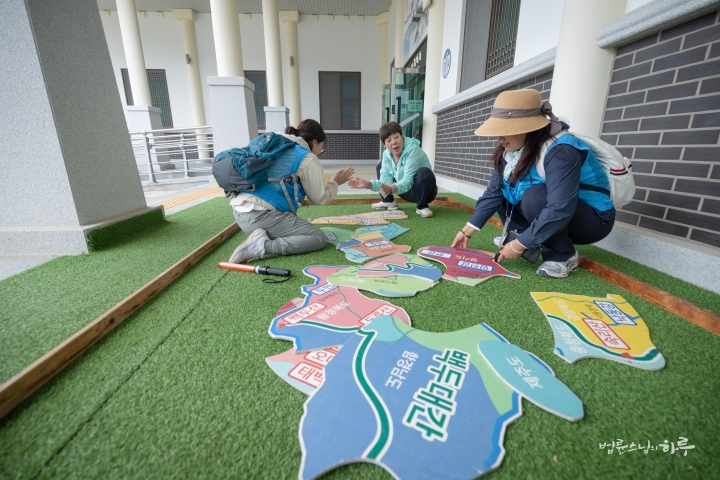
While everyone enjoyed the traditional games, Sunim quietly toured Exhibition Halls 2 and 3 of the History and Culture Center.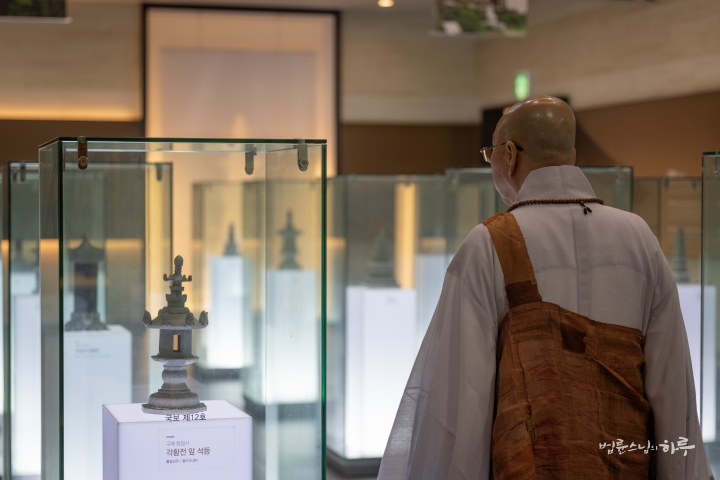
After playing energetically for 30 minutes, everyone was thirsty. After taking a sip of water and resting briefly, they boarded the bus again.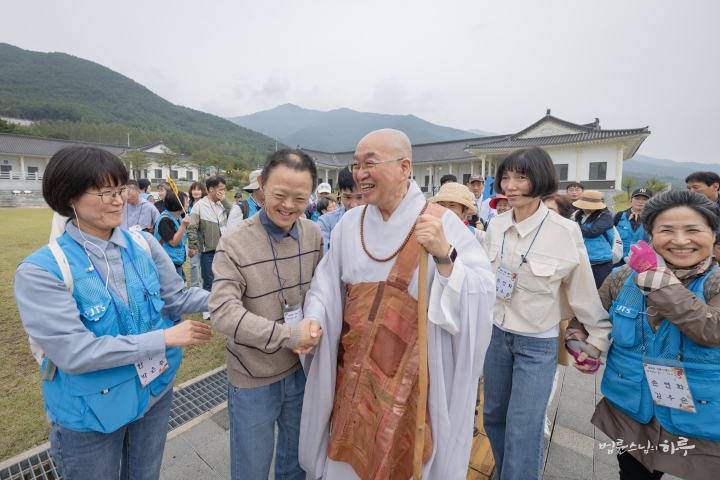
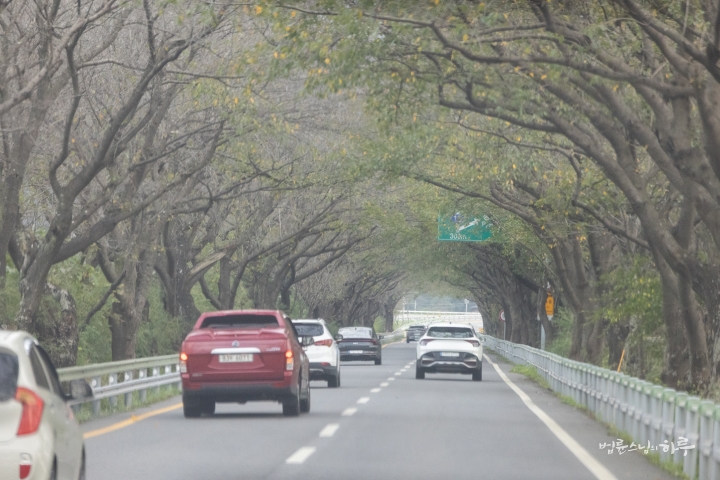
The bus arrived at Cheoneunsa Temple parking lot at 2:30 PM. When all the Aegwangwon residents had gathered, Sunim continued his explanation.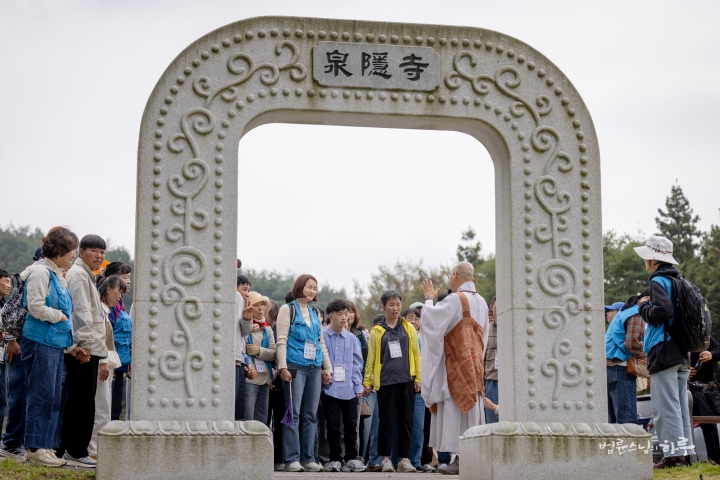
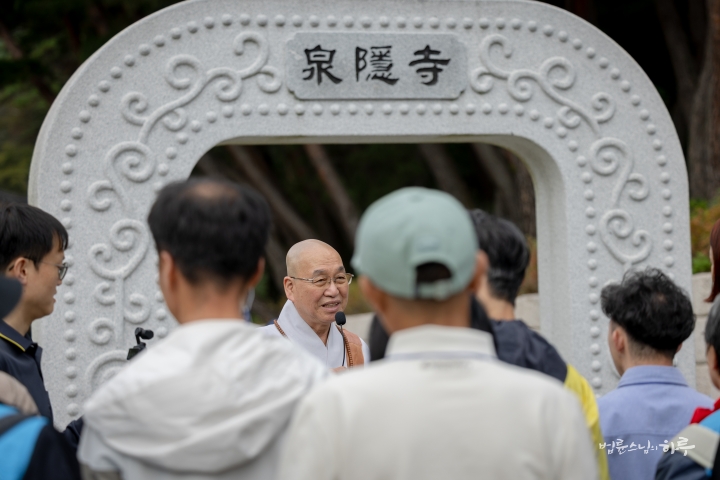
“We’ve arrived at Cheoneunsa Temple. ‘Cheoneun’ means ‘hidden spring.’ This temple was built during the Silla period, and it was originally named Gamnosa because the water from the spring here tasted so good. However, the temple burned down during the Japanese invasions. When they tried to rebuild it, an imugi (mythical serpent) appeared from the spring. After killing the imugi, water stopped flowing from the spring. That’s how it got the name ‘Cheoneunsa,’ meaning a temple with a hidden spring. Later, fires kept breaking out at the temple, so someone wrote ‘Jirisan Cheoneunsa’ in flowing script like water, and the water started flowing again. Believe it or not.” (laughter)
Everyone burst into laughter at Sunim’s entertaining explanation.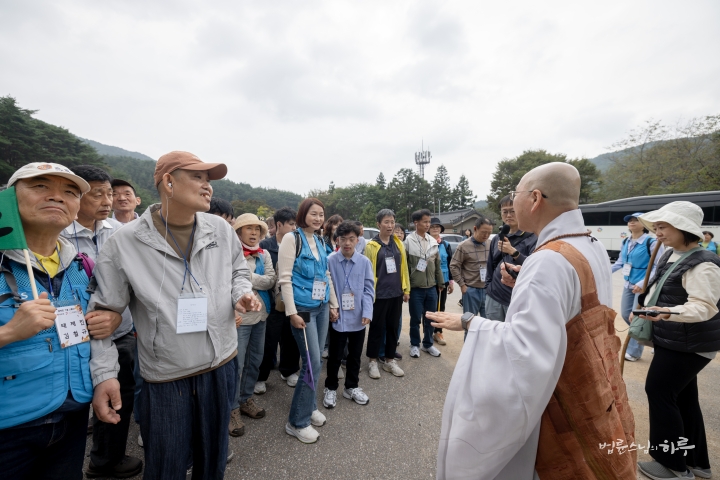
After passing through Iljumun Gate, Suhongnu Pavilion, which crosses the valley, appeared. A beautiful pavilion was built on top of a beautiful bridge. The water flowing beneath Suhongnu flowed directly down to Cheoneun Reservoir. Known as a drama filming location and famous for taking memorable photos, they took a group photo here.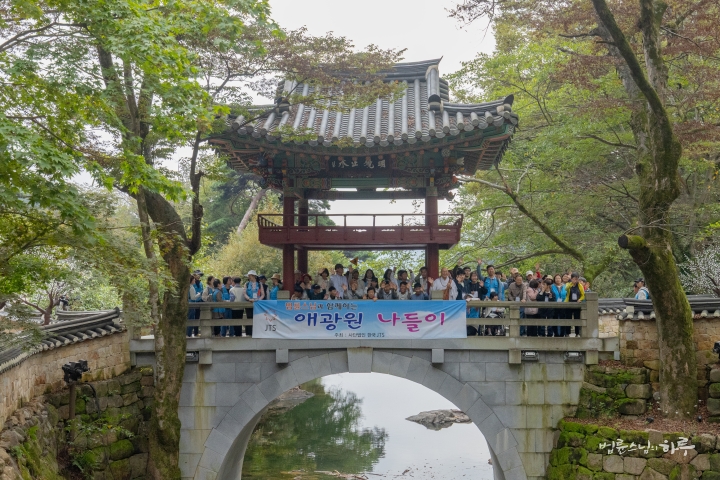
After passing Suhongnu and climbing the stairs, Cheonwangmun Gate appeared.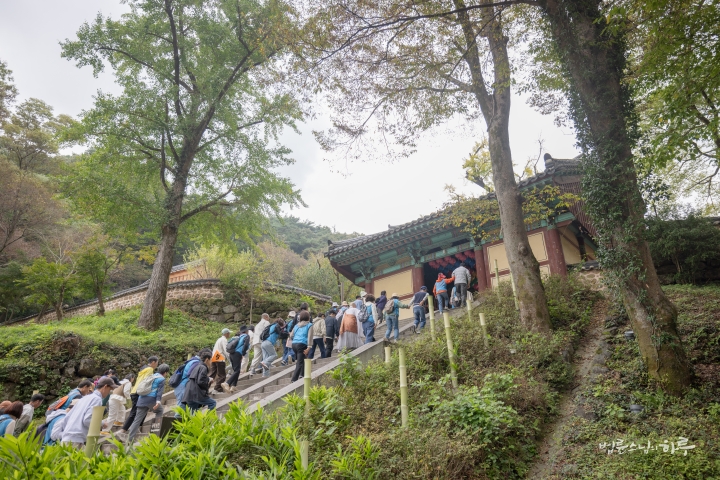
After passing through Cheonwangmun Gate, Daejin Sunim, the abbot of Cheoneunsa Temple, came out to warmly welcome them.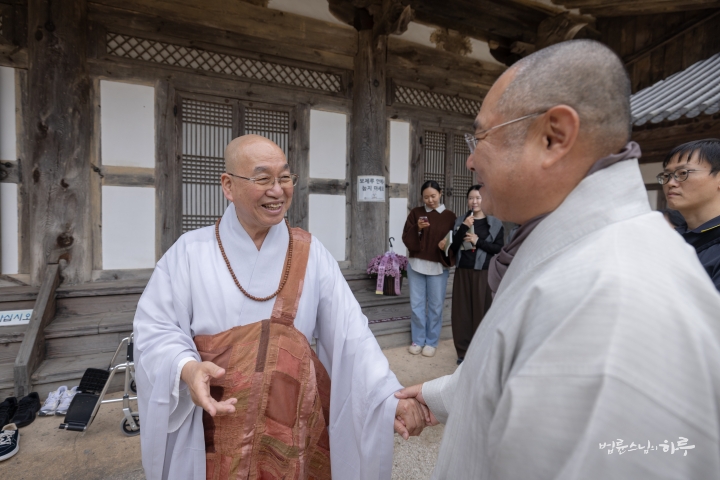
“Thank you for such a warm welcome.”
After passing through Bojeru Pavilion, Geungnakbojeon Hall came into view. They took a commemorative photo in front of Geungnakbojeon Hall and toured Gwaneumjeon Hall, Palsangjeon Hall, Eungjinjeon Hall, and Myeongbujeon Hall in order.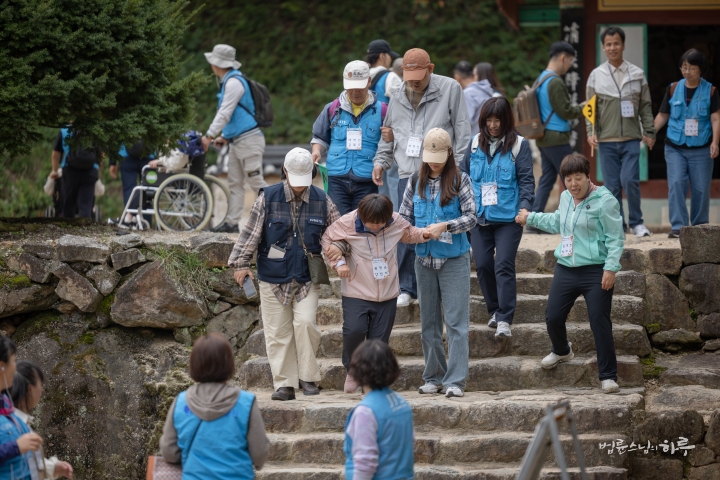
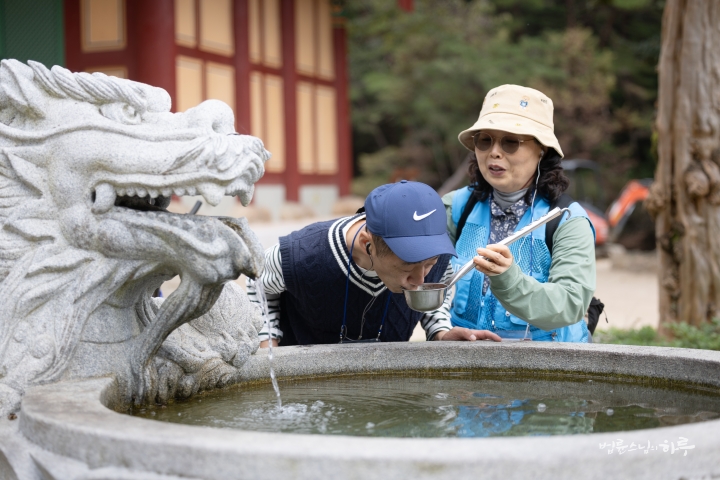
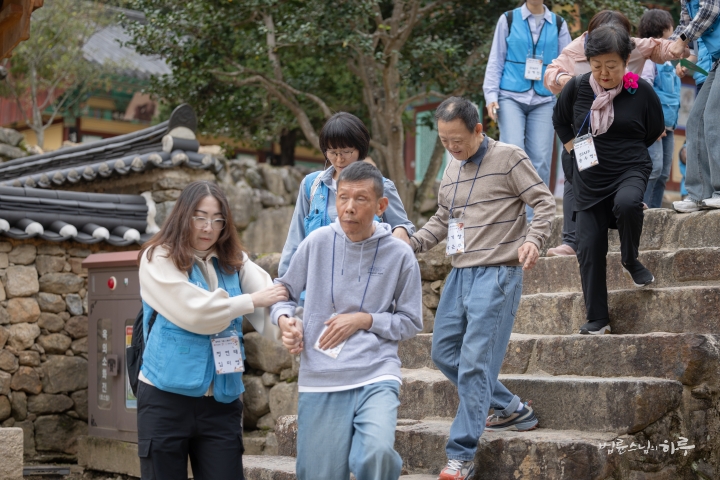
After expressing gratitude to the abbot, they entered Bojeru Pavilion to have recreation time with the Aegwangwon residents.
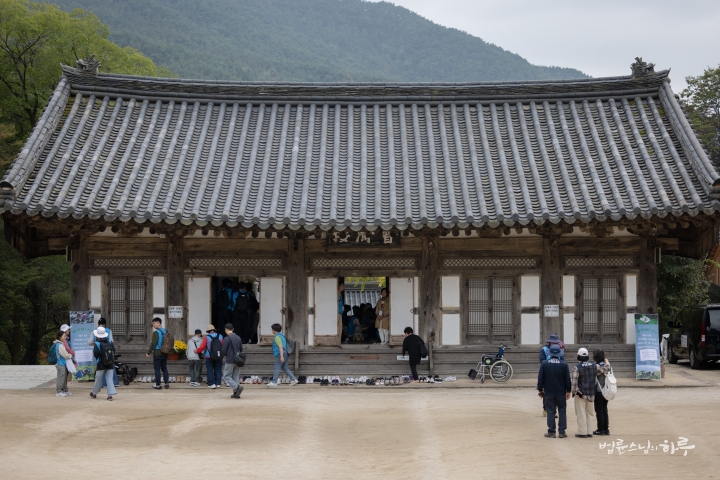
We spent a joyful time singing and dancing together at Bojeru Pavilion as the autumn breeze gently blew through. We began by doing rhythmic exercises to loosen up our bodies. With lively music playing, we clapped our hands, moved our bodies, and shouted out with excitement.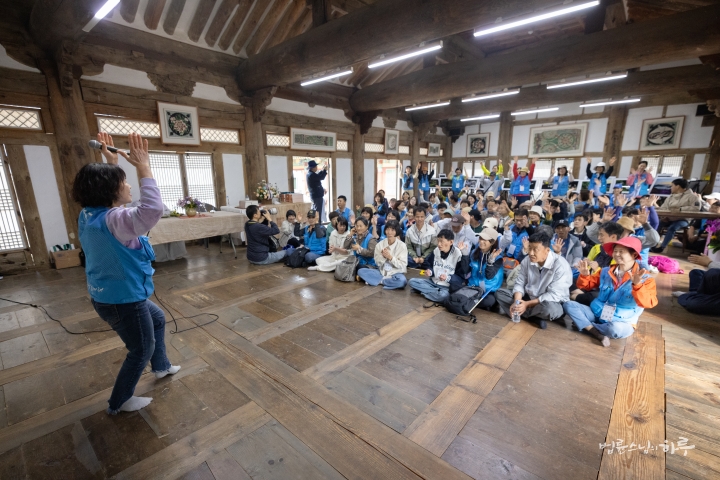
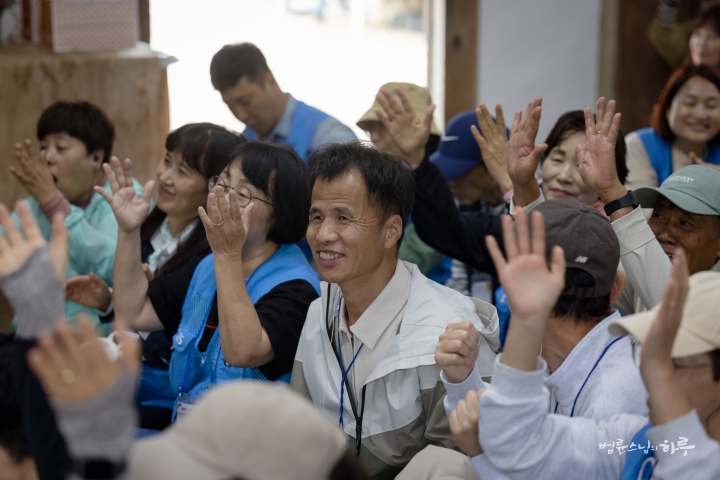
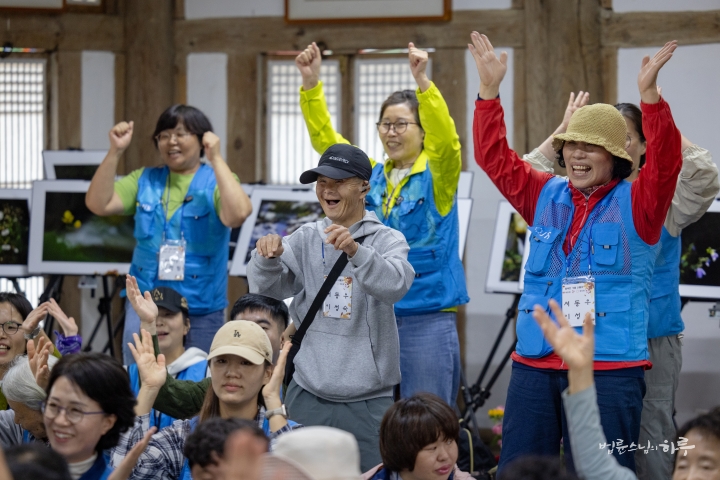
When one person stepped forward and began to dance to the upbeat song, several others joined in, and before long the place turned into a lively disco floor.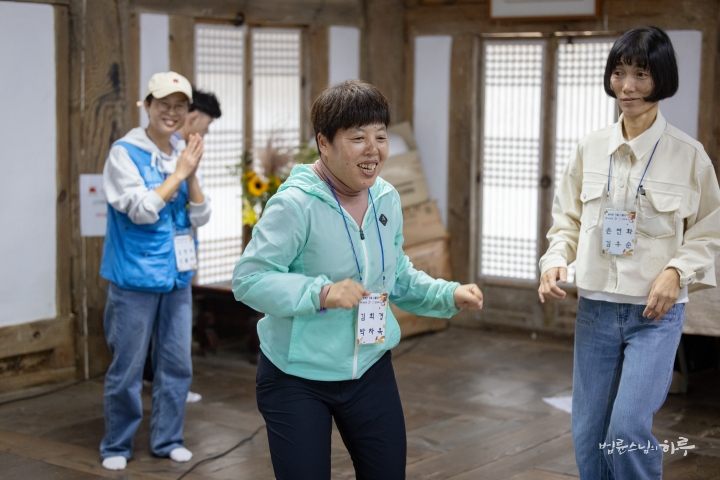
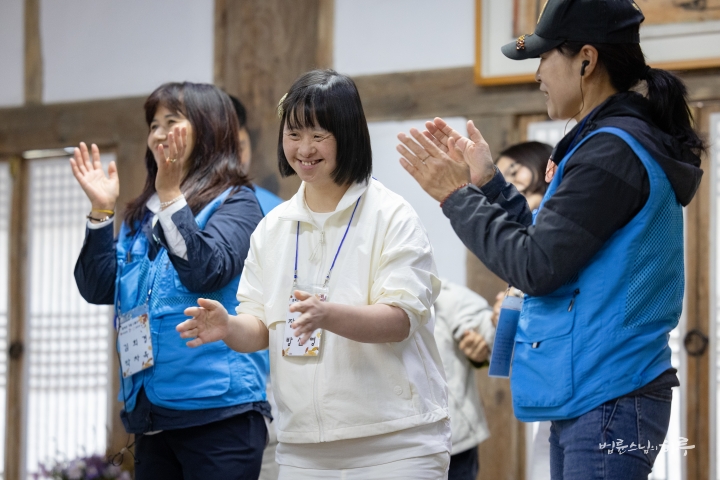
Whenever a familiar tune came on, someone would grab the microphone and start singing.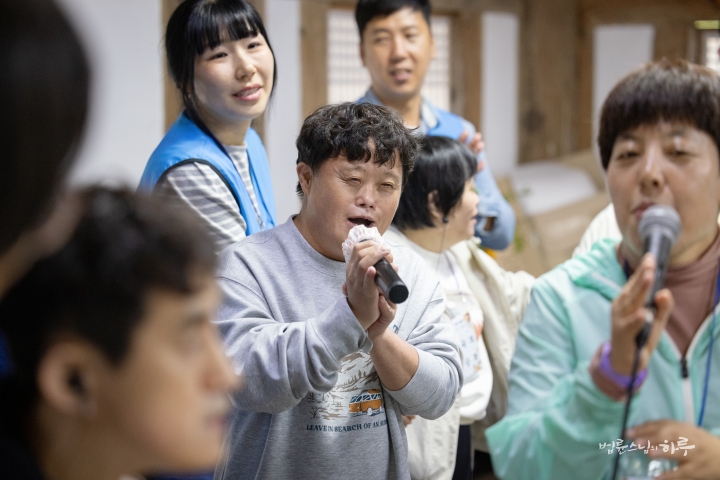
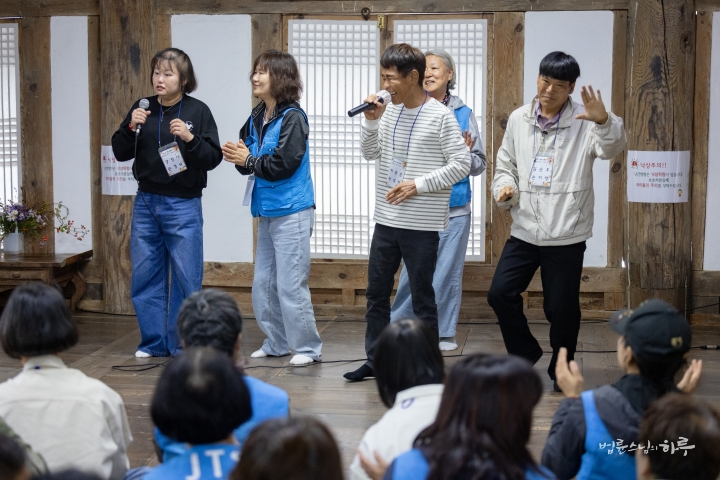
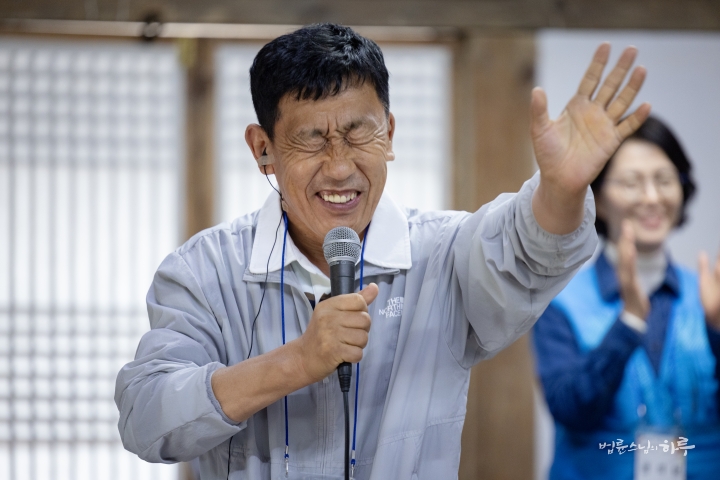
Although the words were sometimes slurred and hard to make out, every sound was still a song. Each time someone sang or danced, Sunim applauded warmly.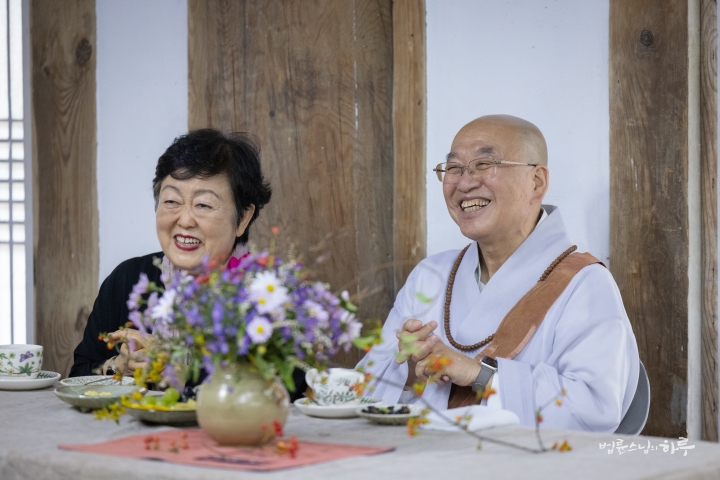
When the energetic disco music ended, one of the residents took the microphone and began singing the song “In the Flower Garden.”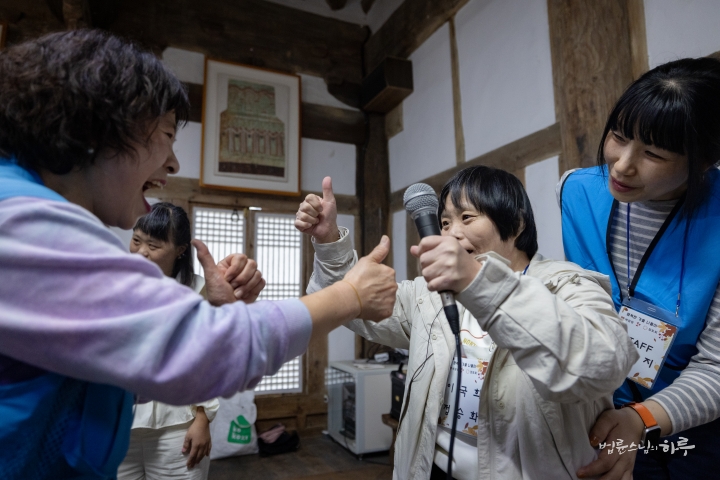
“In the flower garden that Daddy and I made, ♬ the portulacas and balsams are in full bloom.”
As the cheerful music started again, everyone joined in a train dance. Holding onto the shoulders of the person in front and making “chug-chug” sounds, the residents of Aegwangwon broke into bright smiles. Some swayed their hips to the beat, others burst into laughter while moving to the rhythm, and even the volunteers joined hands and danced shoulder to shoulder.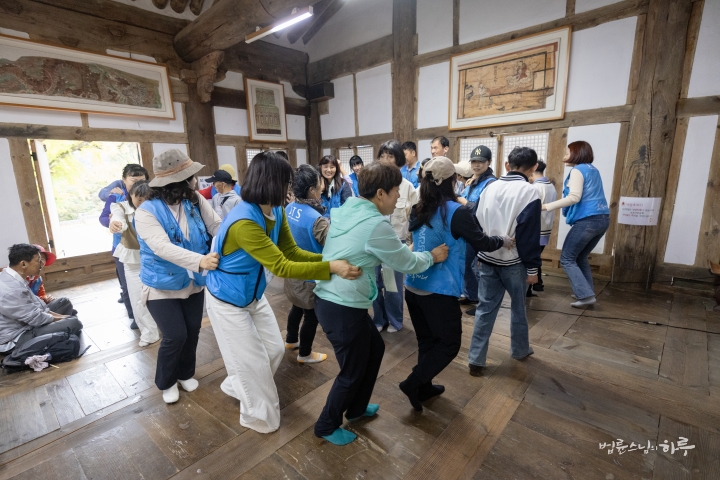
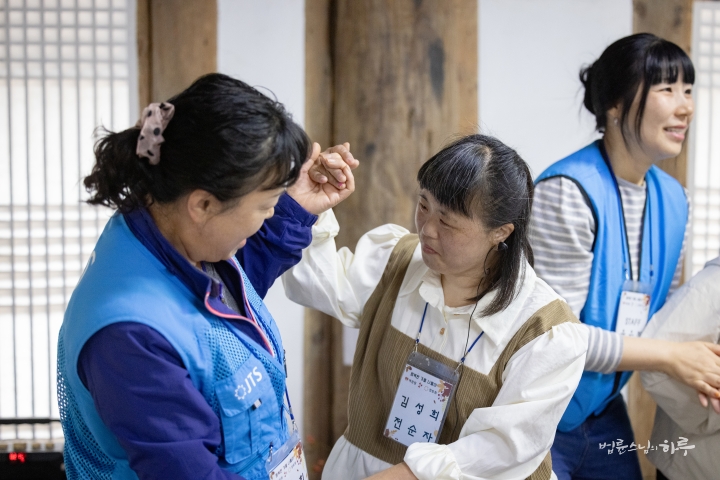
Even those with limited mobility or speech joined in the joy—at that moment, everyone became one train, laughing and dancing as one. As the music sped up, the hall filled with a warm blend of laughter, clapping, and happiness.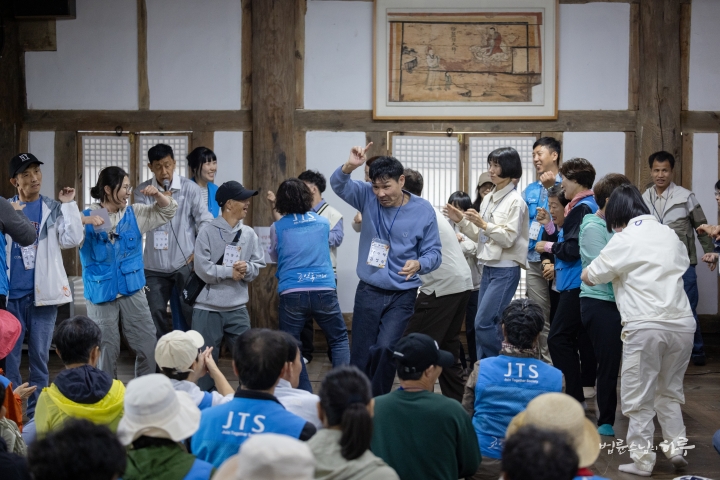
As the day drew to a close, it was time to wrap up the outing. Sunim gave closing remarks to end the day’s trip.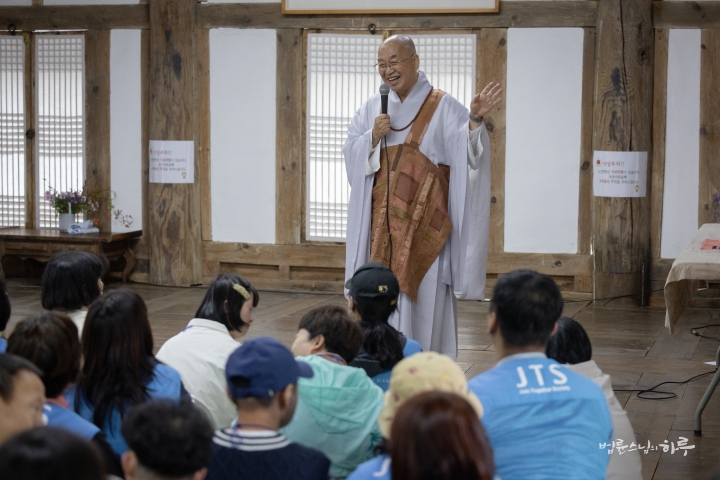
“Did everyone have fun?”
“Yes!”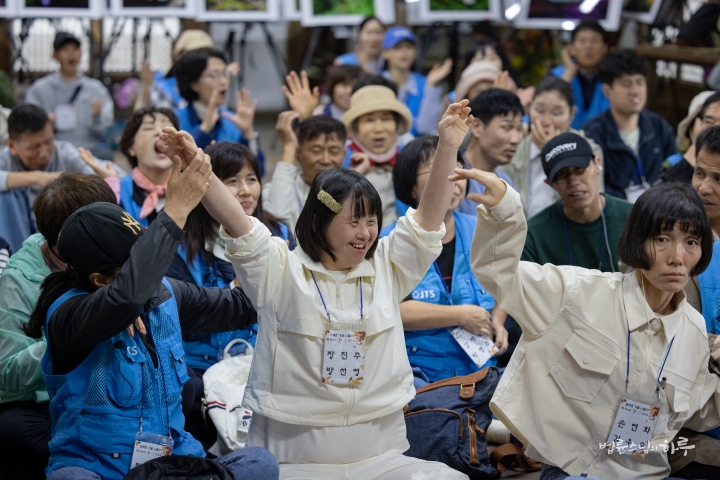
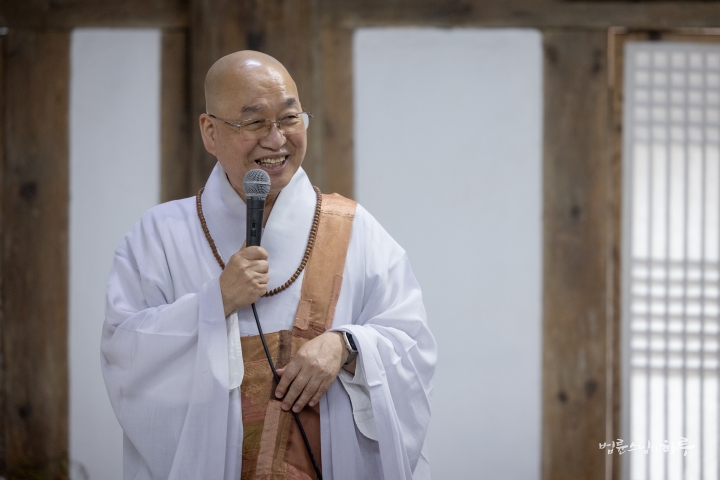
“Watching you all jump and shout, I almost got dizzy! But hearing that you had fun makes me happy too. The teachers at Aegwangwon work very hard to take care of you, don’t they? Let’s all say, ‘Thank you, teachers!’ together.”
The residents shouted in unison,
“Thank you, teachers!”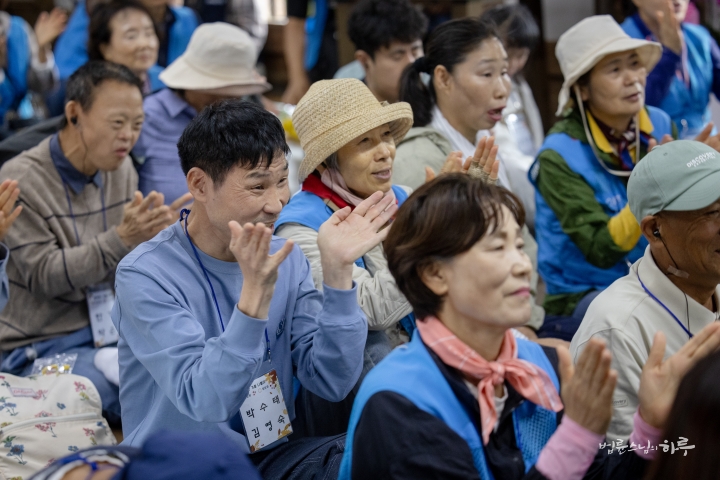
Sunim then presented gifts to the Aegwangwon teachers, giving each of them a copy of The Revolutionary Buddha, and they took a commemorative photo together.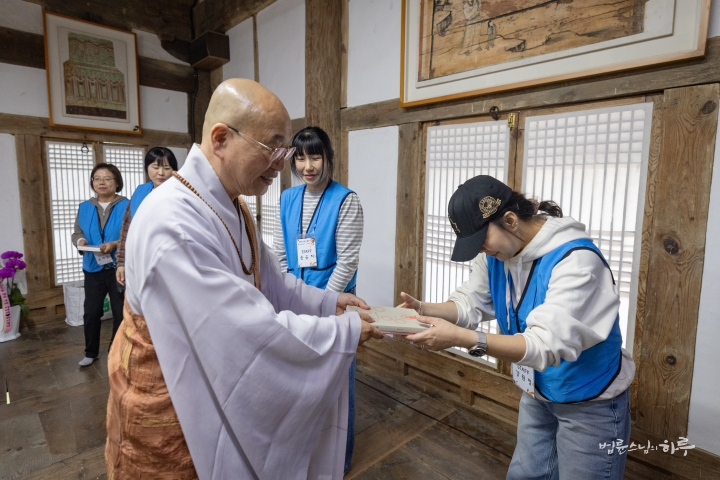
Smiling again, Sunim said,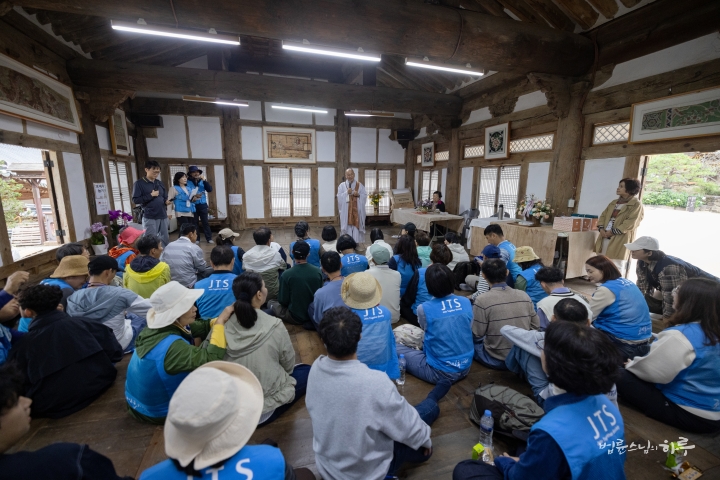
“You all had a great time today, so please listen well to your teachers when you return to Aegwangwon. Normally, in a temple, jumping and shouting like this is not allowed—it’s a place for calm and quiet. I think even the Buddha must have been startled and fallen over from all your excitement today! Let’s also thank the head monk of Cheoneunsa Temple for allowing us to have such a joyful time here.”
“Thank you!”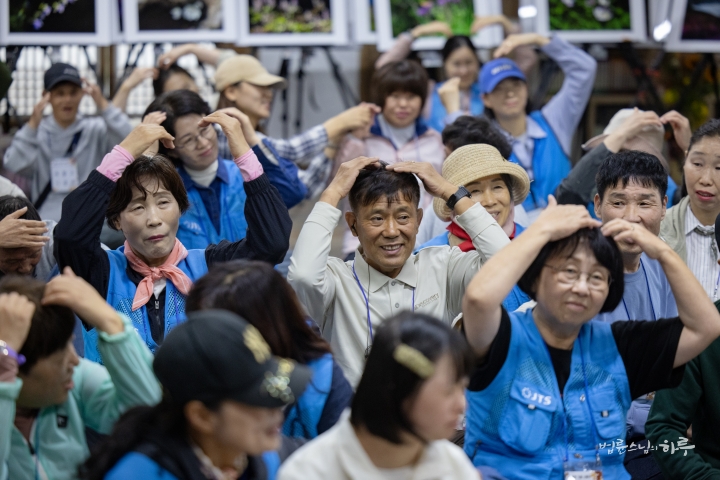
The Aegwangwon teachers, in return, expressed their gratitude by presenting gifts to Sunim and the Jungto Society volunteers.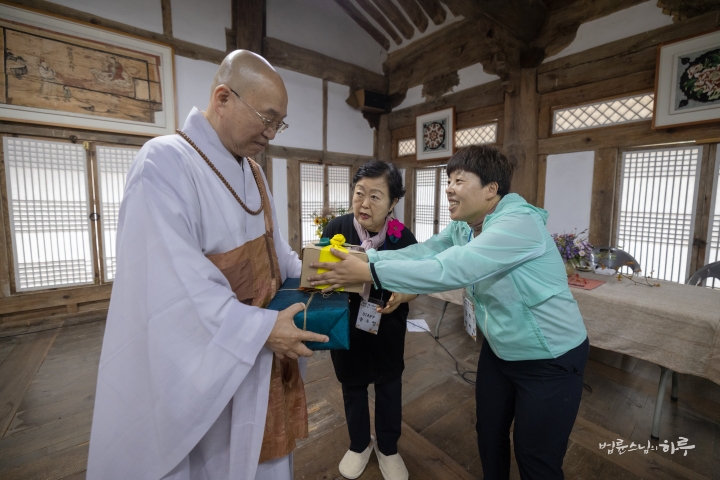
Finally, Director Song, Woo-jeong of Aegwangwon gave closing remarks.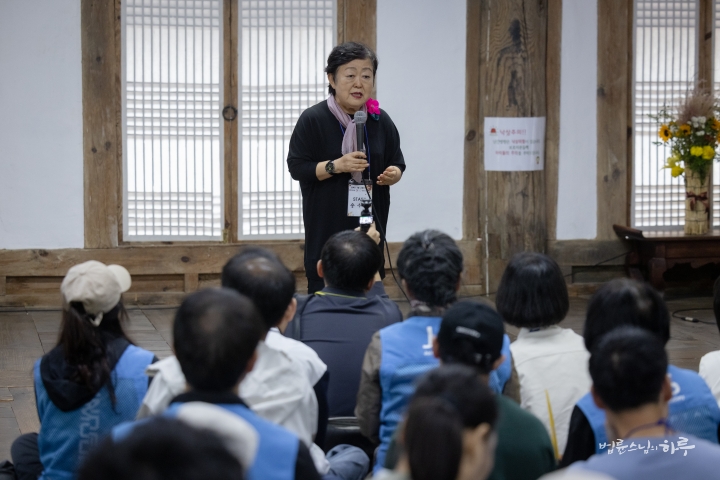
“I think our Aegwangwon friends had more fun today than on any outing before. The volunteers truly understood their hearts and moved in harmony with them — I can’t express my gratitude enough. Watching everyone today, I realized this is what it means to be of one heart and one body. I hope this beautiful companionship continues, and that we can meet again next year with the same joyful spirit. Thank you for giving us such a wonderful day.”
They took one last commemorative photo before leaving Cheoneunsa Temple. When Sunim asked the residents, “Did you all have a good time?” they smiled brightly—some even put their hands together in a bow.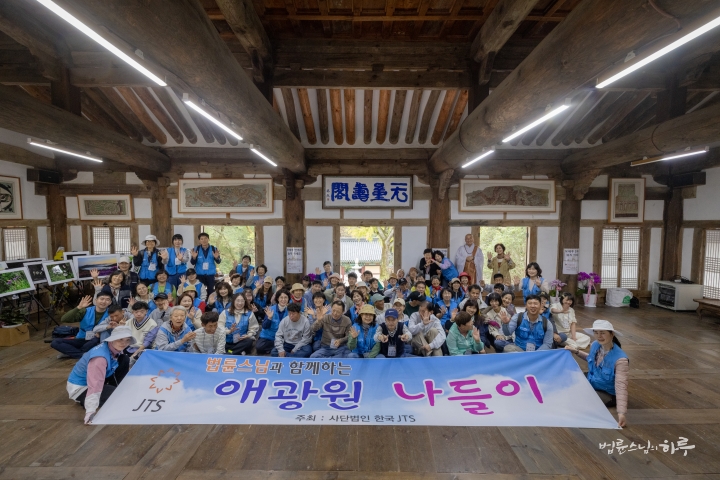
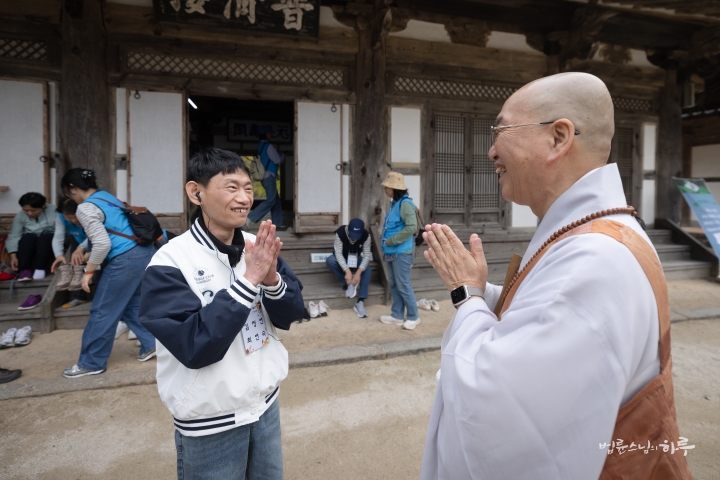
The volunteers gently held the residents’ hands as they carefully walked down the stairs together.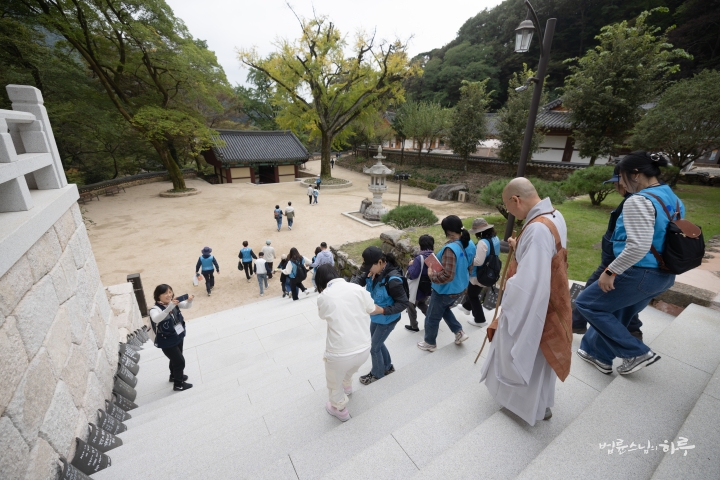
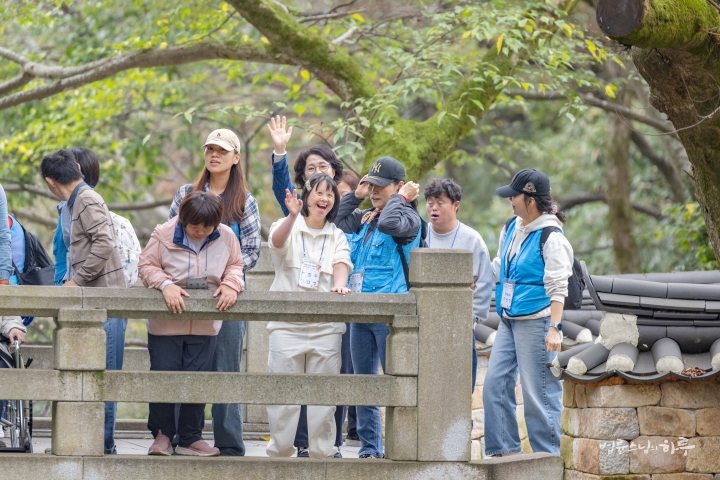
At the parking lot, Sunim said his farewells.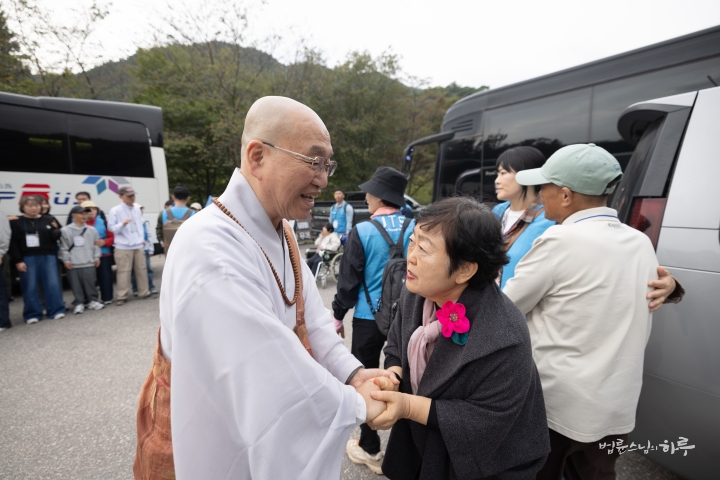
“I have a lecture in Jinju this evening, so I’ll be heading out first. Please enjoy your dinner before returning.”
“Thank you, Sunim.”
After greeting Director Song, Sunim got back into his car. The Aegwangwon family and volunteers headed to a restaurant for dinner, while Sunim drove toward Jinju.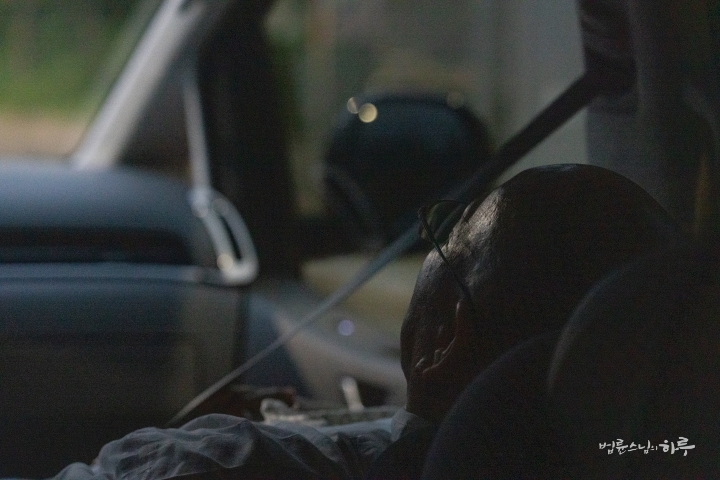
He left Cheoneunsa at 4:30 p.m., drove for about an hour and a half, and arrived in Jinju at 6 p.m. After a simple dinner of noodles near the lecture venue, he headed to the auditorium.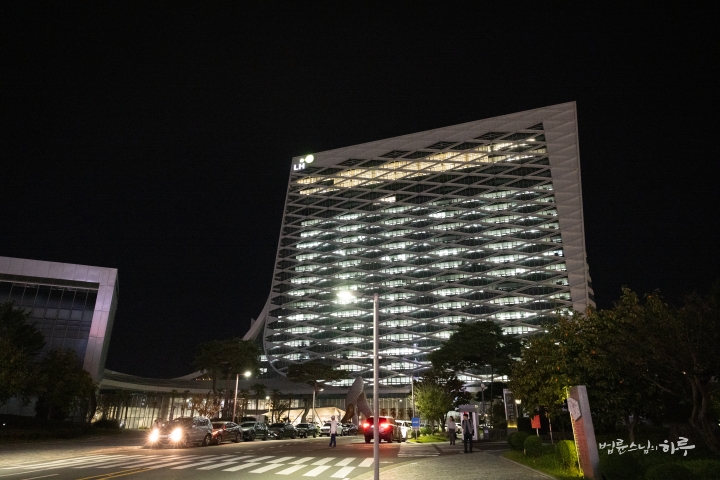
That evening’s talk was held in the main auditorium on the first floor of the LH (Korea Land and Housing Corporation) headquarters in Jinju. In the pleasantly cool evening breeze, people arrived in small groups, lining up to enter the hall.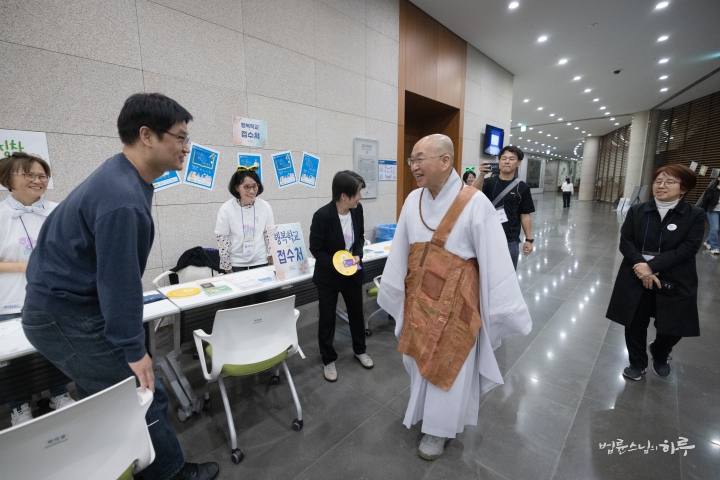
When Sunim arrived, the “Happy Citizens” who organized the event warmly welcomed him. The 800-seat auditorium was packed, and a pre-show performance was underway. Actor Choo, Sung-min was volunteering as the host, while well-known Jinju singer Lee, Maju energized the crowd with two songs, “Ttubuk Ttubuk” and “La La La.”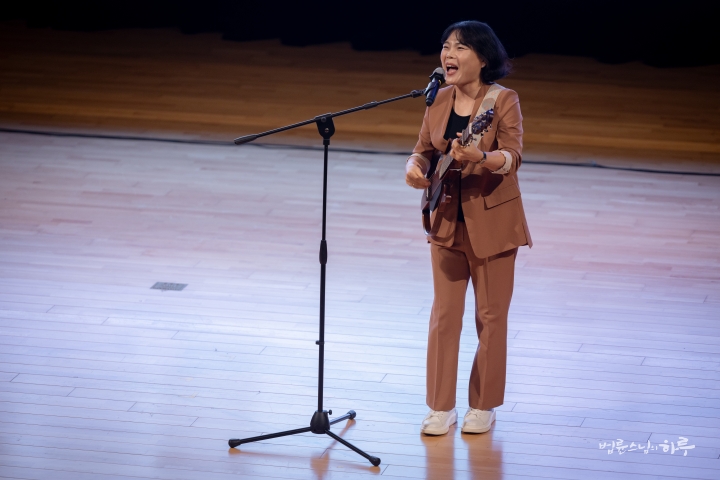
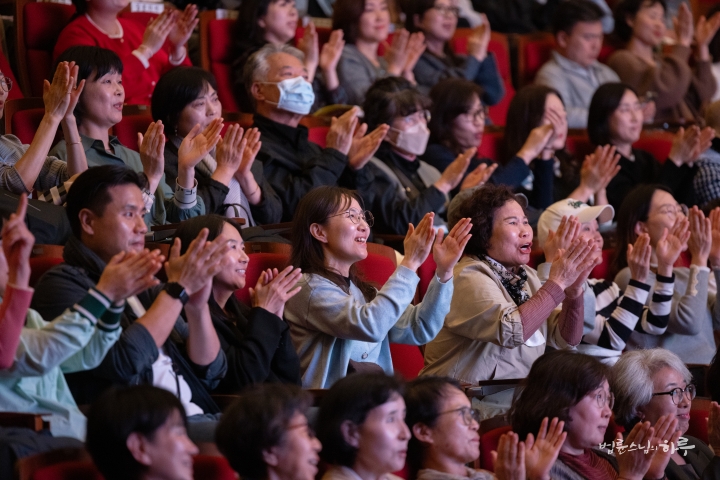
With the atmosphere in full swing, the lecture began at 7:30 p.m. with an introductory video about Sunim. As the video ended, he walked onto the stage to enthusiastic applause and cheers.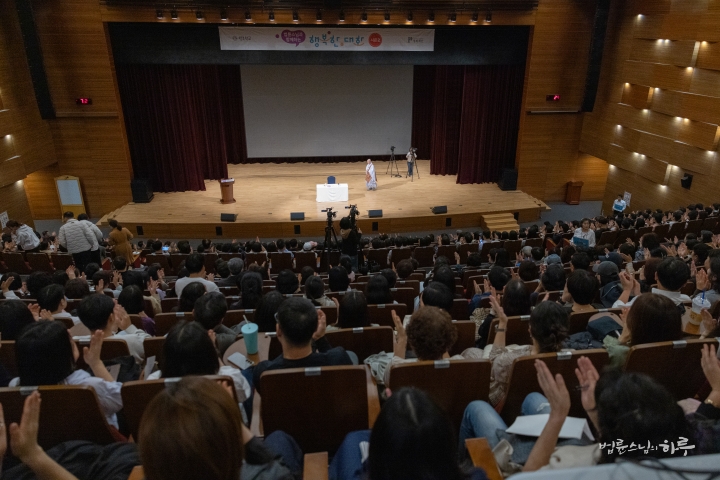
Over 5,400 viewers joined the live broadcast on the YouTube Dharma Q&A with Sunim channel as Sunim greeted the audience.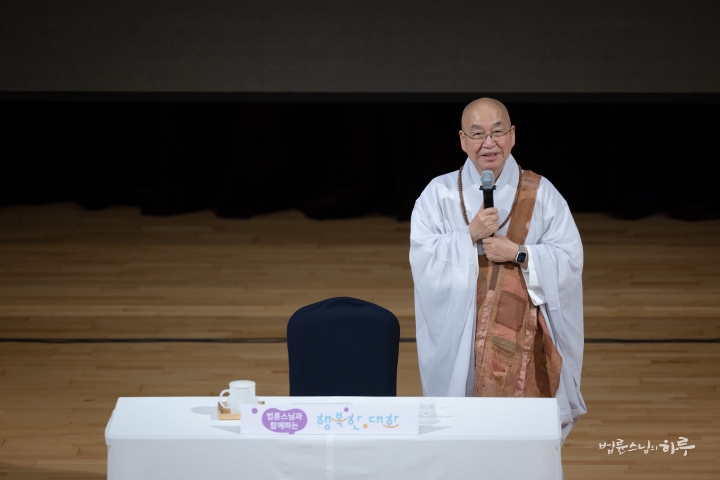
“It’s wonderful to see all of you on this deepening autumn night, and I’d like to thank the performers for the wonderful show earlier. I’ve been in Gurye, Jeollanam-do since this morning, spending the day with the residents of Aegwangwon — a care facility for people with intellectual disabilities in Geoje — visiting Hwaeomsa and Cheoneunsa Temples for an autumn outing. Because those with disabilities often need assistance to move about, it’s not easy for them to go on trips. That’s why we go on outings together twice a year, and this time we chose a nearby destination that fit my lecture schedule in Jinju.
Though the air was a little chilly today, that coolness is what makes autumn truly feel like autumn. It had been raining for several days, but today turned out clear. I do a bit of farming myself, but the frequent rains—almost like the monsoon—have delayed my harvest. The rice has ripened and grown heavy, but with all the rain, many stalks have fallen over. They say it’s a bumper year for rice, but when I actually harvest, I’m afraid there might be some losses.”
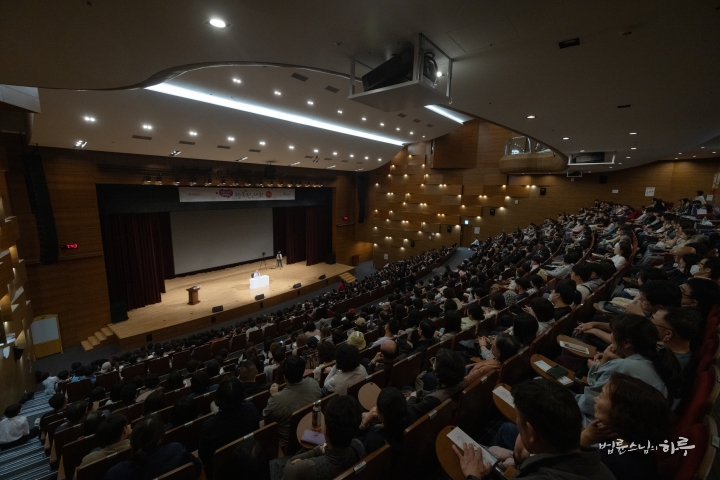
Next, Sunim had conversations with those who had submitted questions in advance. Then he also took questions from people who raised their hands on the spot. During the two hours, nine people had the opportunity to ask Sunim questions. One of them shared concerns about how to change the stubbornness of their mother, who had farmed all her life and whom they wished would now take a rest.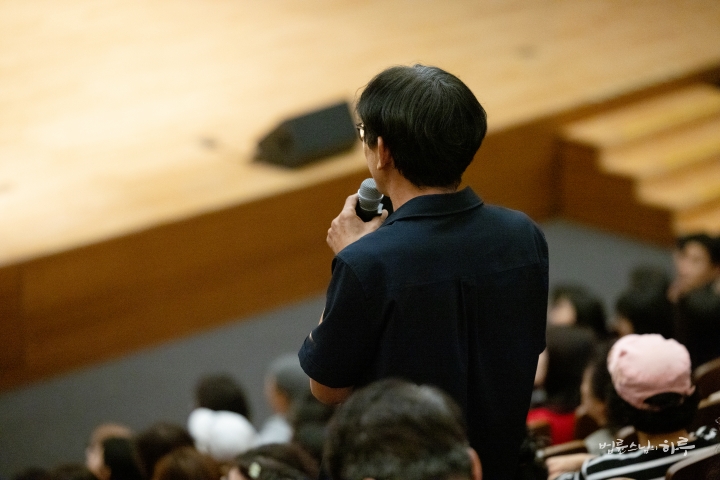
My Stubborn Mother, How Can I Get Her to Stop Farming?
“If you’re so worried about your mother, you could help her with the farming. If you don’t want to help, then don’t. But why are you trying to interfere with your mother’s life?”
“Despite how I may appear, I’m known as a filial son in the village.”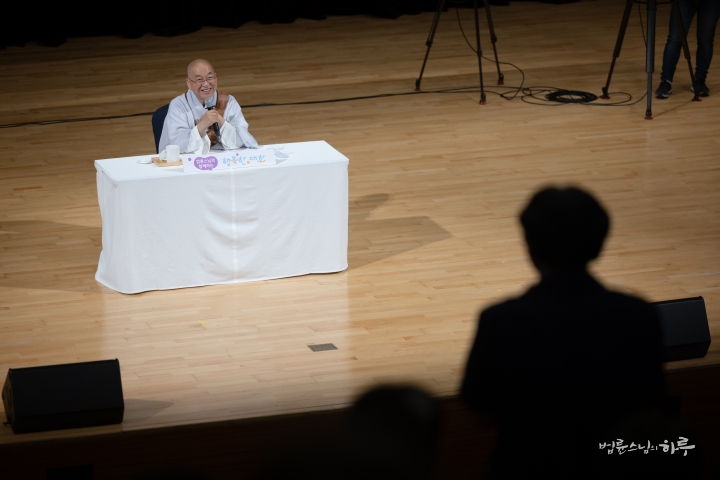
“Is interfering with your mother’s life being filial? Doing what your mother wants is being filial.” (Laughter)
“I feel sorry for my mother.”
“Feeling sorry is your emotion. Your mother farms because she enjoys it, so why do you feel sorry for her? You’re being stubborn with your own thoughts. Inside, you’re thinking, ‘If she’s going to farm, she shouldn’t complain about being in pain. If she’s going to complain about pain, she shouldn’t farm. If she’s going to farm, she shouldn’t call me. If she’s going to call me, she shouldn’t farm.’ In other words, you want your mother to fit into your plans. But your mother will start farming projects, then complain about pain, and even if you tell her not to farm, she’ll farm again. Seeing this, you’re also thinking from your own perspective. 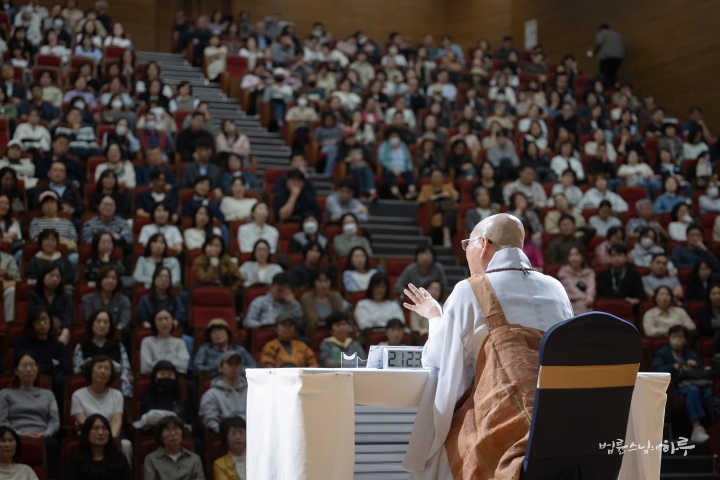
When your mother looks for her hoe in the morning, say ‘Here it is’ and bring it to her. When she says she’s in pain in the evening, massage her. The next morning when she says she’s going to the field, find her hoe, and when she’s in pain, take her to the hospital. When she recovers and wants to go to the field again, find her hoe and take her to the field. This is what a truly filial child does. Don’t try to break your mother’s stubbornness; first break your own stubbornness.”
“But the farming work is too much for my mother to do alone.”
“Then you can help her.”
“I also want to rest on weekends, and it’s too exhausting.”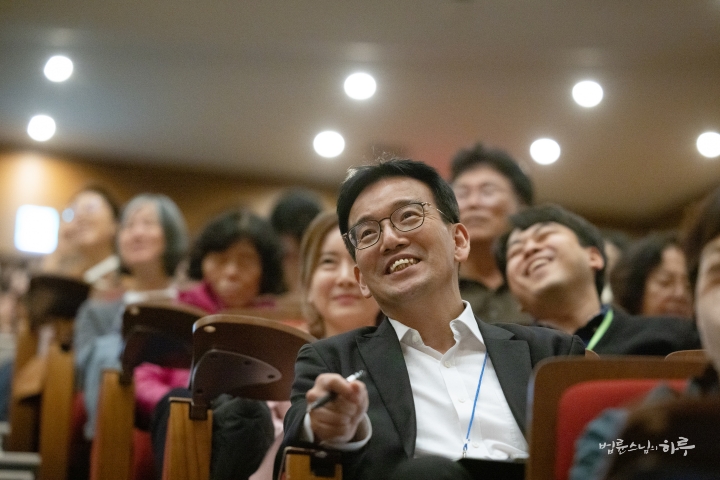
“That’s why I said at the beginning, ‘If you don’t want to help, then don’t help. Don’t blame your mother.’ When your mother asks for help, say ‘Yes, I understand,’ and if you don’t go, that’s fine. If she asks why you didn’t come, say ‘I was busy today and couldn’t make it.’ When she asks you to come again next time, say ‘I understand,’ and if you have time that day, go; if not, don’t go. You’re not your mother’s slave. You don’t have to do everything she tells you to do. However, it’s good to do what you can as a child’s duty. But you find it hard to help, and you’re worried about being called an unfilial child in the village if you don’t help. You have a bad attitude. Who would call such a person filial? (Laughter) 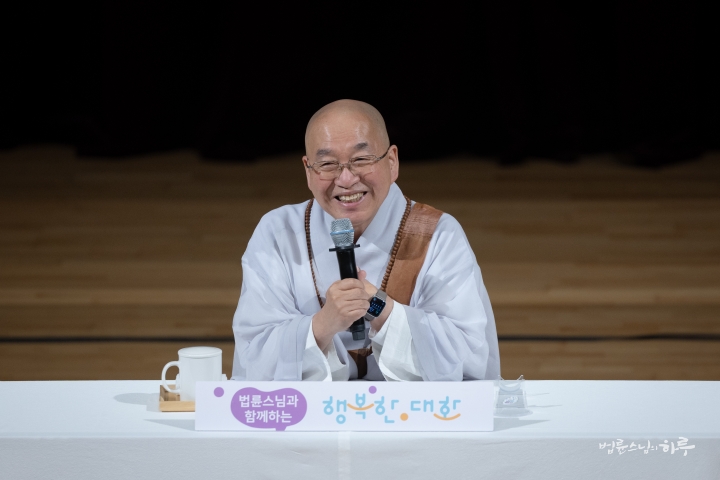
You are not a filial son, but someone who wants to be called a filial son. Don’t try to break your mother’s stubbornness; break your own stubbornness instead. Let your mother do as she wishes. Just because your mother says, ‘Come and help me,’ doesn’t mean you must help unconditionally. If you can help, then help. If you don’t have time to help, just say, ‘Mother, I’m sorry. I couldn’t come today.’ However, you shouldn’t say in advance, ‘I can’t come tomorrow.’ Always respond with ‘Yes’ when she says ‘Come tomorrow,’ and if something comes up the next day, say ‘I couldn’t make it. I’m sorry.’ Elderly people don’t take issue as long as you respond well with ‘Yes’ in the moment.
Do you know what characterizes the elderly? They don’t change. That’s why we need to accommodate them. If you tell your mother, ‘Don’t farm next year,’ she’ll answer, ‘Okay, I understand,’ but when spring comes, she’ll go out and farm again. Getting angry and saying, ‘But you said you wouldn’t do it last year!’ is just being stubborn about your own thoughts. Since your mother has been farming all her life, her body moves automatically. Elderly people will drag themselves to work even a palm-sized piece of land. In the countryside where I farm, there’s an elder over 100 years old who can’t walk. Yet, he drags himself on a sack and does all the field work. Amazingly, the cabbage he grows thrives much better than the cabbage I grow. (Laughter) 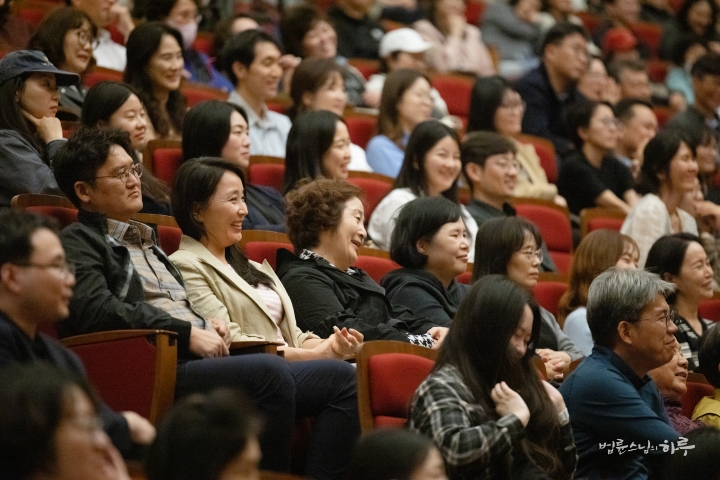
You’re not a filial son, but someone who wants to be called a filial son. First, let go of your stubbornness. Don’t tell your mother what to do or not to do. Just let her do what she wants. That doesn’t mean you have to do everything she asks. Do what you can, and for what you can’t, just say ‘I’m sorry.’ Don’t say things like ‘Why do you start work and then can’t finish it, and come to busy me asking for help?’ That will hurt your mother’s feelings. Just say, ‘Mother, I’m sorry. I couldn’t come because I was busy.’ Help if you can, and if it’s too difficult, don’t do it. Then some farming work will be left undone. When that happens, your mother will adjust the amount of work on her own.”
“Yes, thank you so much.”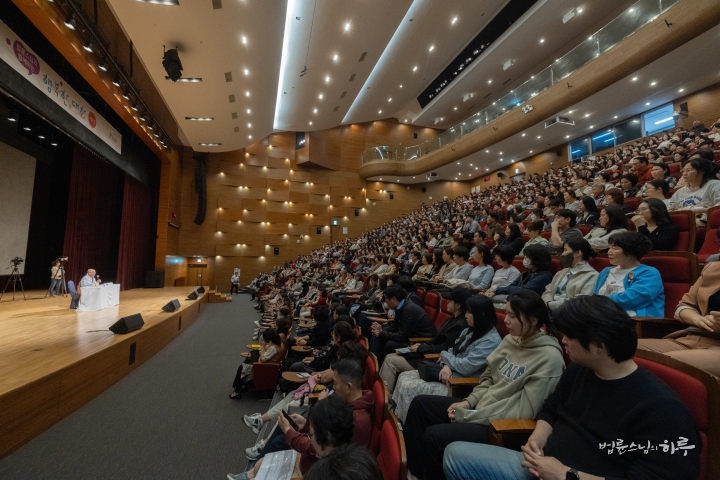
Questions continued one after another.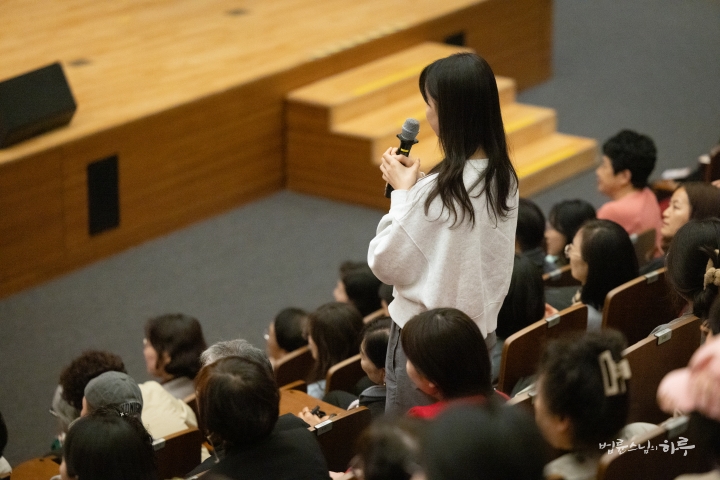
I have a stable job, but I feel this isn’t my path. Should I take on the challenge of doing what I want, or should I continue at my current company?
I feel emptiness and sadness watching a company on the verge of closure. How should I accept this reality as it approaches its end?
I’m too sensitive to others’ emotions and moods, which exhausts me. How can I protect myself while maintaining comfortable relationships with others?
I keep thinking life is meaningless. What perspective should I have to live my life?
Is it okay to live life lightly, like a game, rather than seriously? What does my thought that ‘even an insignificant life can be happy’ mean from a Buddhist perspective?
I’m becoming an increasingly permissive mother because I feel sorry for my children. When I live with my family again, how can I avoid conflicts with my children?
Why did my mother, who practiced with deep faith all her life, pass away so painfully? Does Buddha’s compassion really exist, and how can we receive that compassion?
If both life and death are meaningless, why should we live? What grounds do we have to tell people in great suffering ‘don’t die’?
Many more people wanted to ask questions, but it was time to end the lecture. Finally, Sunim gave his closing remarks.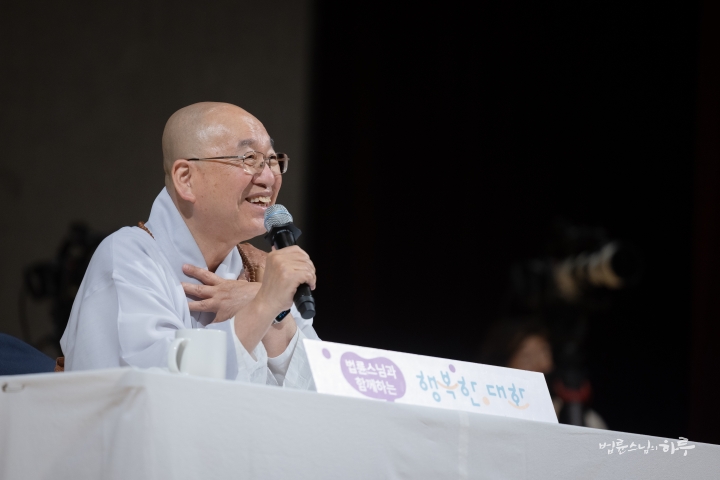
“While Korea’s economy has now entered the top ranks globally, our social welfare and level of mental happiness haven’t kept pace. Though we may appear prosperous on the outside, the hearts of our citizens remain impoverished. It’s not easy for me either to continue traveling nationwide giving Dharma Q&A lectures. I don’t receive speaker fees, and we have to rent venues.
We Must Now Learn How to Live Happily
Nevertheless, the reason I continue with Dharma Q&A is because I want to help restore the mental health of Korean citizens, even if just a little. If my words can bring peace to many people’s hearts, even briefly, that’s rewarding enough for me. Of course, once they leave the lecture hall, they’ll return to their daily lives. (laughter) 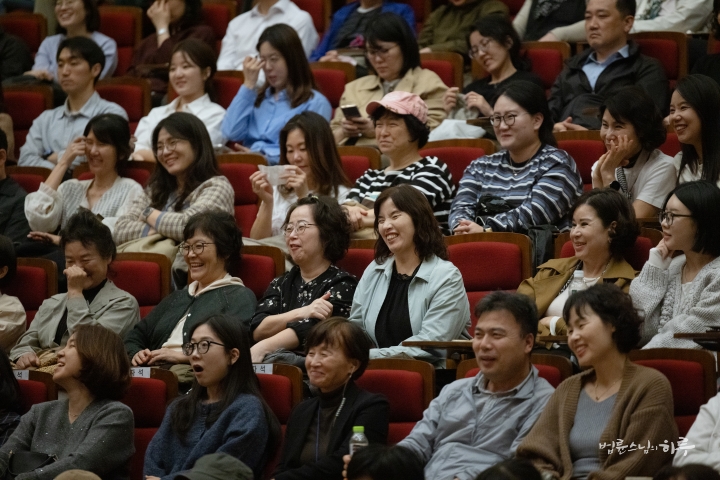
However, this work is impossible with just one or two people’s efforts. We’re now in an era where people’s mental health is more important than religious distinctions like Buddhism, Christianity, or Catholicism. While everyone is free to believe in their own religion, we must work together so all citizens can live happily with healthy minds. Government efforts alone are insufficient, so the private sector must also step forward.
With this purpose in mind, Happiness Schools with Venerable Pomnyun Sunim are being operated nationwide through the efforts of happy citizens. It’s a kind of national happiness movement where people learn how to live happily. I hope many of you will participate in creating lives that are mentally happy to match our material prosperity.” 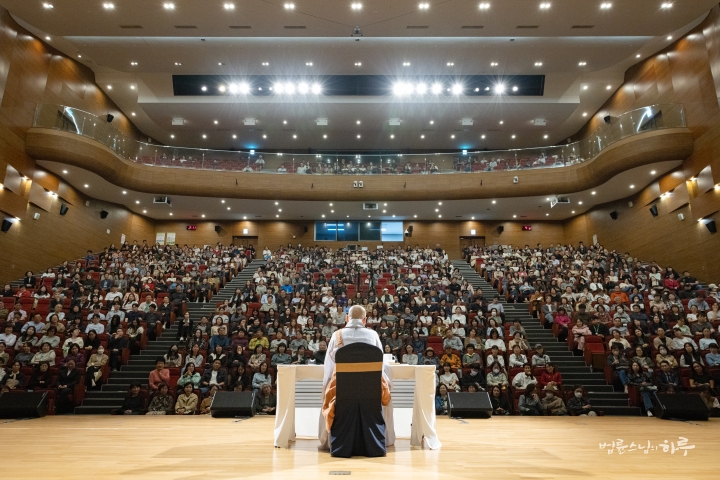
The lecture concluded with thunderous applause.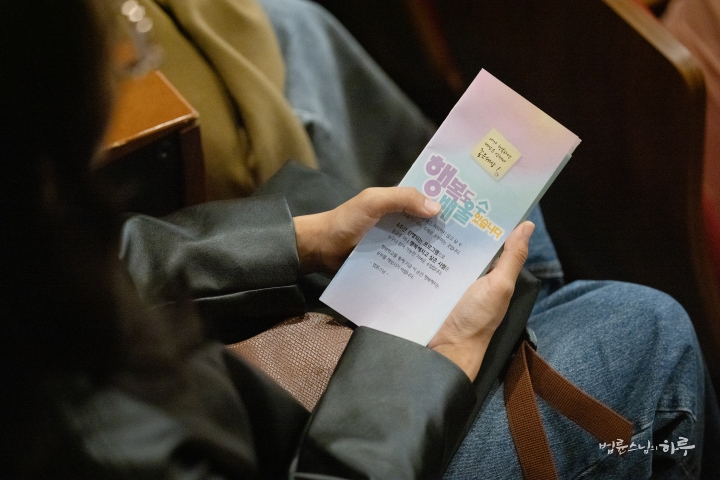
Since the auditorium was provided free of charge, book sales and signing events were not permitted. Sunim bowed with palms together to the departing Jinju citizens before stepping down from the stage.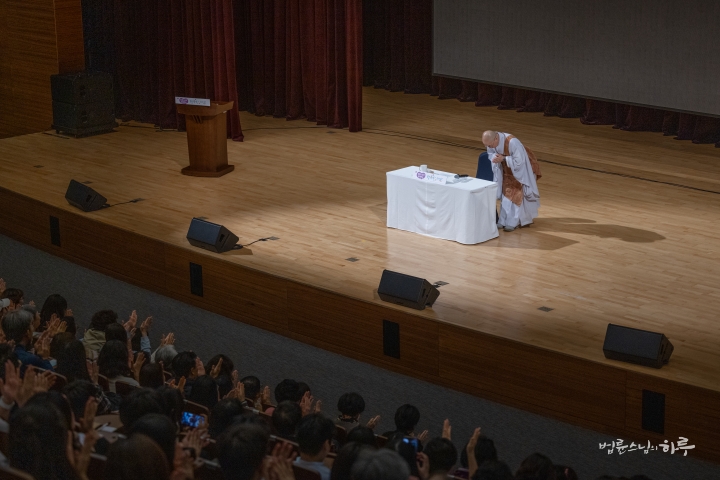
In the lobby, Sunim took a commemorative photo with the Jinju Happy Citizens who had prepared the lecture.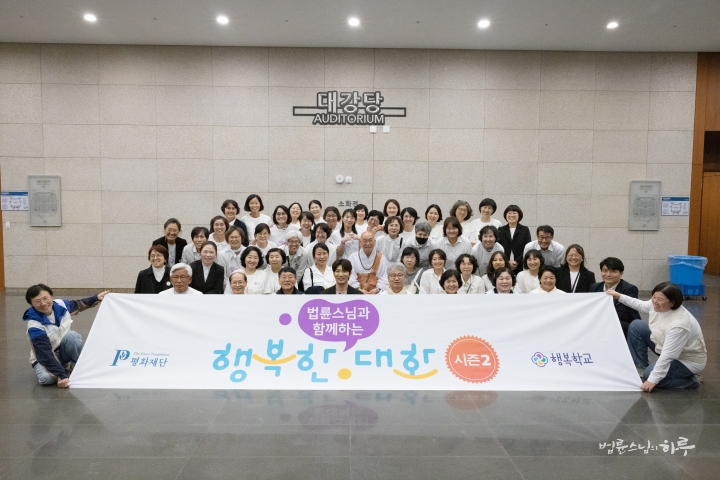
“Jinju Happiness School, fighting!”
All of them were graduates of the Happiness School who were engaged in various community activities in Jinju. After expressing his gratitude to the volunteers, Sunim left the lecture hall.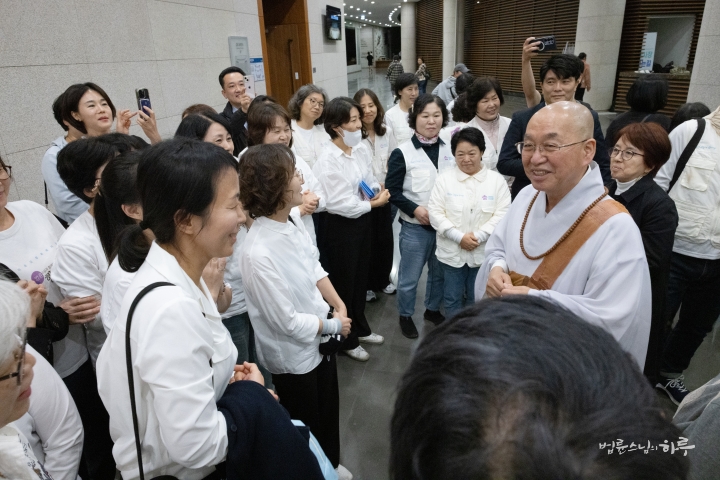
Departing from Jinju at 10 PM, they headed to Seoul. After driving on the highway for 3 hours and 20 minutes, they arrived at Seoul Jungto Center at 1:20 AM and concluded the day’s activities.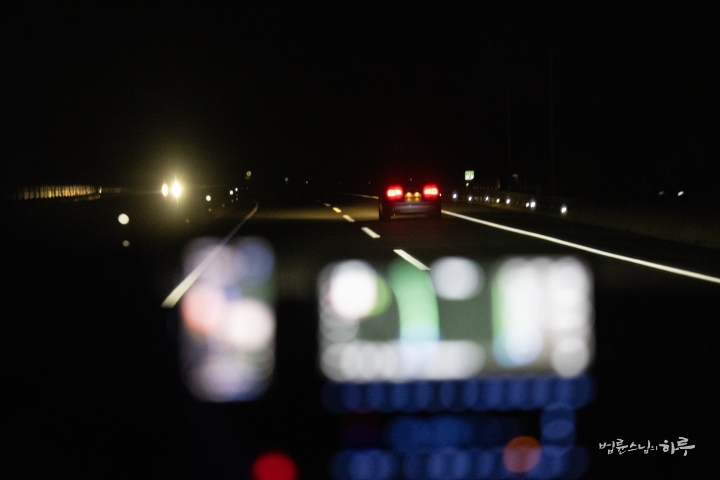
Tomorrow, Sunim will attend a religious leaders’ meeting for national reconciliation and peace in the morning, conduct a live broadcast of the morning Weekly Dharma Assembly, participate in a research seminar on “AI and Human Mental Health” in the afternoon, meet with The Peace Foundation planning committee members, and then conduct a live broadcast of the evening Weekly Dharma Assembly.





